|
Electronic Poster Session
Molecular Imaging |
Monday, 18 June 2018
Electronic PosterMolecular Imaging
3553 -3576 Hyperpolarisation: Technical Developments
3577 -3600 Molecular Imaging
3673 -3696 MR/PET & Molecular Imaging
3697 -3720 Hyperpolarisation: Applications |
| |
Hyperpolarisation: Technical Developments
Electronic Poster
Molecular Imaging
Monday, 18 June 2018
| Exhibition Hall |
16:15 - 17:15 |
| |
|
Computer # |
|
3553.
 |
1 |
 A Late-Stage Deuteration Method for T1 Prolongation and Enhanced In Vivo Signal to Noise Ratio of Hyperpolarized 13C Substrates A Late-Stage Deuteration Method for T1 Prolongation and Enhanced In Vivo Signal to Noise Ratio of Hyperpolarized 13C Substrates
Céline Taglang, David Korenchan, Cornelius von Morze, Chloé Najac, Joseph Blecha, Justin Yu, Sukumar Subramaniam, Robert Bok, Henry VanBrocklin, Renuka Sriram, John Kurhanewicz, David Wilson, Robert Flavell
One of the fundamental limitations of hyperpolarized 13C technology is the effective lifetime of the signal, which decays in keeping with the spin-lattice relaxation constant T1. We have developed a robust late stage deuteration methodology which is broadly applicable to amino and alpha hydroxyl acids, including commonly used probes such as alanine and lactate. This methodology enables significant T1 prolongation, yielding an effective doubling of in vivo signal to noise ratio at relevant imaging time-points. We tested [1-13C, 2-2H]alanine prepared via this method both in vitro and in vivo. This broadly applicable methodology may facilitate implementation and translation of hyperpolarized 13C MRI probes.
|
|
3554.
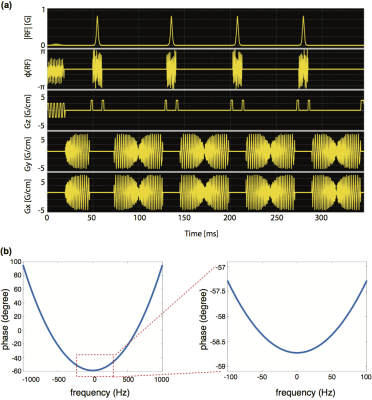 |
2 |
 Spiral-In/Out Multi Spin-Echo Acquisitions for Increased SNR in Dynamic Hyperpolarized 13C MRI Spiral-In/Out Multi Spin-Echo Acquisitions for Increased SNR in Dynamic Hyperpolarized 13C MRI
Shuyu Tang, Robert Bok, Eugene Milshteyn, Daniel Vigneron, Peder Larson
The long T2 relaxation time of hyperpolarized 13C-labeled metabolites at 3T allows efficient use of hyperpolarized signal by multi spin-echo readouts. This work presents a novel 13C sequence that uses spiral in/out acquisitions at multiple spin echoes, each formed by a single adiabatic pulse to improve signal-to-noise ratio(SNR) in dynamic hyperpolarized 13C MRI. The proposed sequence was tested in vivo on a normal rat on a clinical 3T scanner. Results show that the proposed method has improved SNR for 15 dynamic acquisitions over 30s.
|
|
3555.
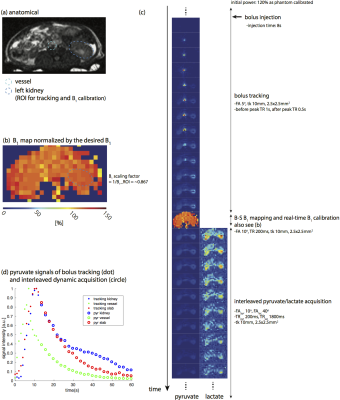 |
3 |
 Developing a Regional Bolus Tracking and Real-time B1 Calibration Method for Hyperpolarized 13C MRI Developing a Regional Bolus Tracking and Real-time B1 Calibration Method for Hyperpolarized 13C MRI
Shuyu Tang, Eugene Milshteyn, Galen Reed, Jeremy Gordon, Robert Bok, Daniel Vigneron, Peder Larson
Acquisition timing and B1 calibration are two key factors that affect the quality and accuracy of hyperpolarized 13C MRI. This project developed a new approach using regional bolus tracking to trigger Bloch-Siegert B1 mapping and real-time regional RF power compensation, followed by dynamic imaging of hyperpolarized 13C metabolites. The feasibility of applying the proposed framework for in vivo hyperpolarized 13C imaging was demonstrated on healthy rats and tumor-bearing mice on a clinical 3T scanner. This proposed method was designed to improve efficient use of hyperpolarized magnetization as well as the accuracy and robustness of hyperpolarized 13C MRI.
|
|
3556.
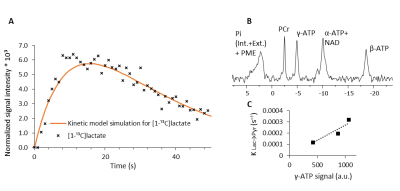 |
4 |
 A perfused heart system to simulate first pass observation of rat cardiac metabolism with hyperpolarized [1-ąłC]pyruvate and determination of LDH flux using selective excitation A perfused heart system to simulate first pass observation of rat cardiac metabolism with hyperpolarized [1-ąłC]pyruvate and determination of LDH flux using selective excitation
Gal Sapir, Talia Harris, Assad Azar, Atara Nardi-Schreiber, Ayelet Gamliel, Jacob Sosna, Moshe Gomori, Rachel Katz-Brull
Aberrant cardiac metabolism is linked to major health issues in the Western world including diabetes and heart failure. New tools are needed to investigate these conditions and to allow better diagnosis. In this work we used dissolution dynamic nuclear polarization NMR spectroscopy (dDNP-NMR) to investigate [1-13C]pyruvate metabolism in the isolated rat heart. A perfusion system simulating in vivo first-pass hemodynamics was used to measure the enzymatic flux through lactate dehydrogenase (LDH) using product selective excitation. LDH flux was found to be 52 ± 8 nmol lactate/s/g wet weight (n=3).
|
|
3557.
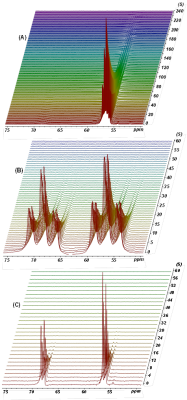 |
5 |
 The effect of ąH-decoupling on hyperpolarized ąłC signal decay – a study on choline chloride analogs and comparison to the effect of deuterium substitution of directly bonded protons The effect of ąH-decoupling on hyperpolarized ąłC signal decay – a study on choline chloride analogs and comparison to the effect of deuterium substitution of directly bonded protons
Sivaranjan Uppala, Gamliel Ayelet, Atara Nardi Schreiber, Talia Harris, Jacob Sosna, J. Moshe Gomori, Rachel Katz-Brull
The spin-lattice relaxation time (T1) of a DNP molecular probe is a key parameter in acquiring NMR signals in dissolution-DNP (d-DNP) experiments. Using molecular probes with long T1, NMR spin signals can survive for a duration sufficient for the study of metabolism (1-3 min). Deuteration of directly bonded 13C protonated positions has been useful in prolonging the visibility of hyperpolarized labeled 13C sites that are otherwise protonated. Here, we sought to investigate whether proton irradiation could affect the T1 of such 13C nuclei when such positions are in their naturally abundant form, i.e. directly bonded to protons.
|
|
3558.
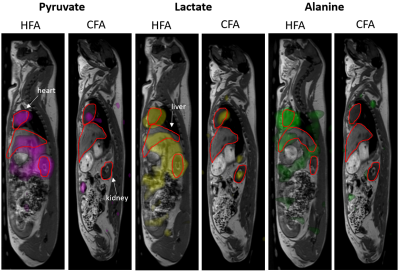 |
6 |
 Optimizing signal-to-noise ratio for hyperpolarized carbon-13 magnetic resonance imaging using a hybrid flip angle scheme Optimizing signal-to-noise ratio for hyperpolarized carbon-13 magnetic resonance imaging using a hybrid flip angle scheme
Lauren Smith, Trevor Wade, Alireza Akbari, Conrad Rockel, Lanette Friesen-Waldner, Charles McKenzie
Hyperpolarized 13C imaging can provide useful metabolic information; however, rapid decay of hyperpolarized signal leads to reduced signal-to-noise ratio (SNR) images. We demonstrate an RF excitation scheme that dynamically changes the RF spectral profile and amplitude to achieve flip angles that vary throughout the acquisition independently for each metabolite. This preserves signal during a dynamic imaging experiment maintaining more signal for later time-points than using a constant RF pulse. Increased in vivo SNR at later time points of [1-13C]pyruvate and its metabolites was shown by dynamic imaging experiments in guinea pigs with both constant and variable flip angle schemes.
|
|
3559.
 |
7 |
 Optimized Single Shot 3D Sequence for High Resolution Hyperpolarized 13C Imaging Optimized Single Shot 3D Sequence for High Resolution Hyperpolarized 13C Imaging
Jiazheng Wang, Richard Hesketh, Alan Wright, Kevin Brindle
We have developed a single-shot 3D sequence for hyperpolarized 13C MRI, which uses a spatial-spectral (SpSp) pulse for excitation, a train of adiabatic pulses for refocusing, and a stack-of-spirals acquired through a fast-spin-echo train. The sequence achieved an isotropic image resolution of 1.25x1.25x1.25 mm3 in vivo on a 7 T animal system, where hyperpolarized [1-13C]pyruvate and [1-13C]lactate were imaged alternately at a frame rate of 2 s per metabolite. Signals from extra spirals acquired from later spin echoes were averaged with those from the early echoes to give a high signal-to-noise ratio (SNR) as well as high spatial resolution.
|
|
3560.
 |
8 |
 Multichannel Hyperpolarized 13C MRI in a Patient with Liver Metastases using Multi-slice EPI and an Alternating Projection Method for Denoising Multichannel Hyperpolarized 13C MRI in a Patient with Liver Metastases using Multi-slice EPI and an Alternating Projection Method for Denoising
Rie Hansen, Jeremy Gordon, Peter Shin, Zihan Zhu, Daniele Mammoli, Pamela Munster, Rahul Aggarwal, Michael Ohliger, Peder Larson, Lars Hanson, Jan Ardenkjćr-Larsen, Daniel Vigneron
Hyperpolarized 13C-pyruvate for monitoring metabolism of liver metastases in vivo is being investigated for clinical trials of new therapeutics. This study applied advances in multichannel receive arrays and sequence design for human 13C liver imaging and investigated a new denoising method. The method is based on an alternating projection method to enforce structuredness and low-rankness, and is applied with automatic threshold estimation. In vivo data demonstrate improved quality of kinetic modeling after denoising. However, simulations revealed certain unresolved pitfalls.
|
|
3561.
 |
9 |
 Slice Profile Induced Errors in Metabolic Quantification of Hyperpolarized Pyruvate. Slice Profile Induced Errors in Metabolic Quantification of Hyperpolarized Pyruvate.
Christopher Walker, James Bankson
Hyperpolarized pyruvate is being explored as a quantitative imaging biomarker of metabolism. Non-ideal slice excitation of hyperpolarized magnetization can result in temporally evolving slice profiles. This work evaluates the impact of slice profile on quantitative analysis of hyperpolarized pyruvate using a perfused Bloch-McConnell simulator. Results indicate that the slice profile can cause significant bias in the measured apparent metabolic exchange constant. Primary sources of bias are excess signal from the slice penumbra and the offset between metabolite slices. Therefore, it will be critical to properly account for the slice profile when attempting to quantify hyperpolarized signal using slice selective excitations.
|
|
3562.
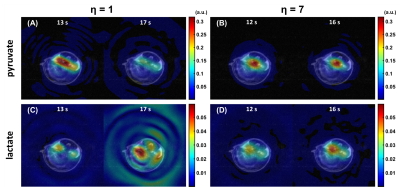 |
10 |
 Improving robustness of hyperpolarized 13C MRSI using k-t spiral acquisitions Improving robustness of hyperpolarized 13C MRSI using k-t spiral acquisitions
Erin Adamson, Benjamin Cox, Sean Fain
Hyperpolarized 13C MRSI with chemical shift encoding relies on a priori knowledge of the N 13C-labeled metabolite resonances and N+1 echoes to fully determine the reconstruction. However, the a priori frequencies may shift due to B0 inhomogeneity, local susceptibilities, or motion, causing spectral leakage, blurring, and biased quantitative measures. To address these uncertainties, we apply IDEAL-based k-t spiral imaging with field-of-view oversampling to further constrain the signal model-based reconstruction in situations where the echo-spacing may be suboptimal, and we test the results in digital simulations, phantom experiments, and in vivo studies of murine renal metabolism. Results support improved metabolic quantification.
|
|
3563.
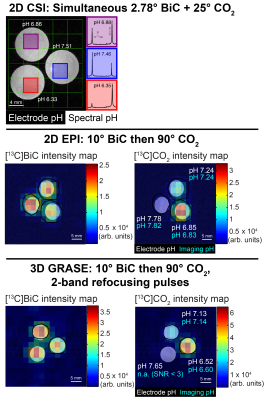 |
11 |
 Mitigating Chemical Exchange Effects in Advanced Pulse Sequences for pH Imaging with Hyperpolarized [13C]bicarbonate Mitigating Chemical Exchange Effects in Advanced Pulse Sequences for pH Imaging with Hyperpolarized [13C]bicarbonate
David Korenchan, Jeremy Gordon, Sukumar Subramaniam, Renuka Sriram, Peder Larson, Robert Flavell, John Kurhanewicz
Imaging extracellular acidification in tumors will likely lead to better characterization of tumor aggressiveness and treatment efficacy. Hyperpolarized (HP) [13C]bicarbonate magnetic resonance spectroscopic imaging (MRSI) can map pH in murine tumors, but images generally suffer from low signal-to-noise ratio (SNR) and coarse spatial resolution. Although sophisticated pulse sequences can boost SNR, pH accuracy can be compromised due to bidirectional [13C]bicarbonate <-> 13CO2 chemical exchange during imaging. We investigated several pulse sequences and excitation/refocusing schemes, and a modified 2D echo-planar imaging sequence with spectral-spatial excitation demonstrated the best combination of spatial resolution, pH accuracy, and potential for future clinical implementation.
|
|
3564.
 |
12 |
Modeling In Vivo Metabolism of Hyperpolarized Pyruvate in Human Brain Tumor Patients.
Video Permission Withheld
Daniele Mammoli, Jeremy Gordon, Adam Autry, Peder Larson, Hsin-Yu Chen, Mark Van Criekinge, Lucas Carvajal, Ilwoo Park, James Slater, Robert Bok, Jason Crane, Markus Ferrone, John Kurhanewicz, Susan Chang, Daniel Vigneron
We show preliminary results of hyperpolarized [1- 13C]pyruvate injected in 9 patients affected with glioma. Raw data showed excellent SNR. Variable bolus delivery and magnitude images introduced errors in modeling the conversion of pyruvate into lactate: kinetic models were presented and compared quantitatively to address these issues.
Finally, reliable and spatially-resolved maps of kPL rates were obtained, which can be useful in future to assess the clinical relevance of the method for both diagnosis and response to therapy.
|
|
3565.
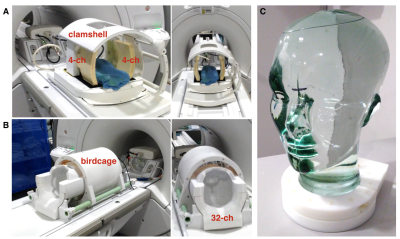 |
13 |
 Comparison between 8- and 32-channel phased-array receive coils for in vivo hyperpolarized C-13 brain imaging Comparison between 8- and 32-channel phased-array receive coils for in vivo hyperpolarized C-13 brain imaging
Adam Autry, Jeremy Gordon, Lucas Carvajal, Ilwoo Park, Daniele Mammoli, Hsin-Yu Chen, Susan Chang, Yan Li, Duan Xu, Daniel Vigneron, Sarah Nelson
This study sought to evaluate the performance of the first 32-channel head coil for in vivo hyperpolarized 13C brain imaging by comparison against a conventional 8-channel receiver array. Initial phantom experiments characterized the B1+ homogeneity and SNR profiles associated with each hardware configuration via EPI-based imaging techniques. As part of a clinical trial, in vivo dynamic EPI data were also acquired from patients with brain tumors. Phantom and patient data revealed improved uniformity, coverage, and SNR with the 32-channel array that will promote higher resolution and acceleration. In vivo data also demonstrated unprecedented detection of bicarbonate using both hardware platforms.
|
|
3566.
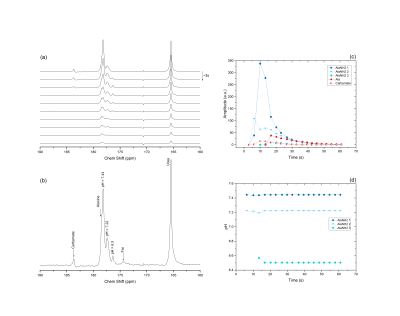 |
14 |
Probing renal pH and aminopeptidase N activity with hyperpolarized [1-13C]alaninamide
Video Permission Withheld
Alice Radaelli, Hikari Yoshihara, Ryunosuke Hata, Shinsuke Sando, Rolf Gruetter
The detection of aminopeptidase N (APN) activity can give information on tumor development. Hyperpolarized L-[1-13C]alaninamide is a specific, sensitive probe of APN activity in kidney homogenate. Here, we characterized its in vivo metabolic response in the rat kidney. In addition to being an APN substrate, L-[1-13C]alaninamide is sensitive to pH and also reacts with dissolved carbon dioxide. To avoid spectral overlap, alaninamide is best suited as an APN probe in acidic environments, and it may have additional applications as a multifunctional sensor of pH and CO2.
|
|
3567.
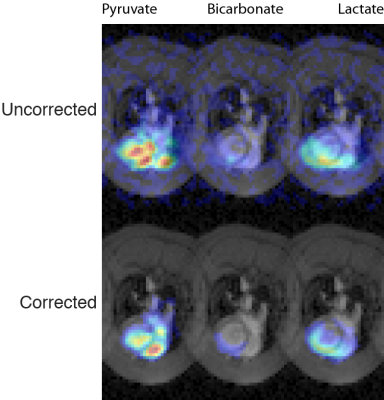 |
15 |
 Susceptibility-Induced Distortion Correction in Hyperpolarized Echo Planar Imaging Susceptibility-Induced Distortion Correction in Hyperpolarized Echo Planar Imaging
Jack Miller, Angus Lau, Damian Tyler
Echo Planar Imaging is an attractive rapid imaging readout that can image hyperpolarized compounds in vivo. By alternating the sign of the phase encoding gradient waveform, spatial offsets arising from uncertain frequency shifts can be determined. We show here that blip-reversed EPI can also be used to correct for susceptibility and $$$B_0$$$ inhomogeneity effects that would otherwise produce image-domain distortion in the heart, through the use of an estimated deformation field that is calculated from the acquired data.
|
|
3568.
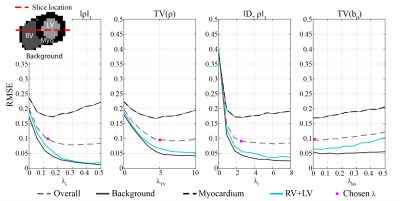 |
16 |
 Extended Signal Modelling and Regularization for Multi-Echo Hyperpolarized Metabolic Image Reconstruction Extended Signal Modelling and Regularization for Multi-Echo Hyperpolarized Metabolic Image Reconstruction
Julia Busch, Valeriy Vishnevskiy, Maximilian Fuetterer, Claudio Santelli, Constantin von Deuster, Sophie Peereboom, Mareike Sauer, Thea Fleischmann, Nikola Cesarovic, Christian Stoeck, Sebastian Kozerke
The IDEAL signal model for hyperpolarized metabolic imaging is extended and spatiotemporal regularization and b0-map recalibration is included. The approach is tested on simulated data and in-vivo metabolic imaging data of the heart. Allowing variable b0-fields and including sparsity regularization signal leakage and ghosting can be significantly reduced (average reduction of root-mean-square error (RMSE) by 16% and 30%). Spatial and temporal regularization of the metabolite intensities considerably improved accuracy of the estimate in terms of RMSE with additional reductions by 68% and 20%, respectively. Thus, the metabolic conversion of [1-13C]pyruvate into [1-13C]lactate and 13C-bicarbonate can be measured with improved accuracy.
|
|
3569.
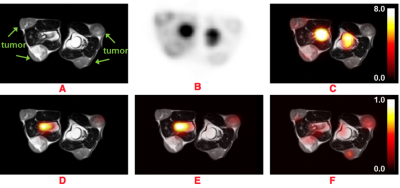 |
17 |
 Combined FDG-PET and hyperpolarized pyruvate-MRSI (hyperPET) for cancer metabolic phenotyping – a pilot study Combined FDG-PET and hyperpolarized pyruvate-MRSI (hyperPET) for cancer metabolic phenotyping – a pilot study
Sissel Bisgaard, Andreas Clemmensen, Abubakr Eldirdiri, Helle Johannesen, Jan Henrik Ardenkjćr-Larsen, Adam Hansen, Andreas Kjćr
Molecular imaging of cancer metabolism in vivo is increasingly employed in clinical settings. Both 18F-FDG PET and hyperpolarized [1-13C]pyruvate MRSI are sensitive to glucose metabolism but differ in which part of the glycolytic pathway is probed. We hypothesize that hyperPET may improve cancer specific metabolic phenotyping. Simultaneous 18F-FDG PET and hyperpolarized [1-13C]pyruvate MRSI (hyperPET) was used in a pilot study, examining the metabolic characteristics exhibited by four different cancer cell lines in nude mice. The results indicated that the combined modalities may distinguish between cancer types.
|
|
3570.
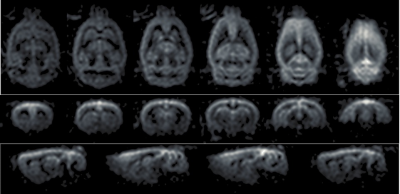 |
18 |
 Improved Hyperpolarized Cerebral Perfusion Imaging Using a Sucrose/Water Glassing Matrix for tert-Butanol Improved Hyperpolarized Cerebral Perfusion Imaging Using a Sucrose/Water Glassing Matrix for tert-Butanol
Gopal Varma, Patricia Coutinho de Souza, Cody Callahan, David Alsop, Aaron Grant
Perfusion imaging is a promising application for hyperpolarized tracers, as they provide high signal with no endogenous background. Hyperpolarized 13C labeled tert-butanol is a freely diffusible perfusion agent with long T1 and T2 relaxation times in vivo. Prior work has shown that tert-butanol can be polarized to 5-10% using dynamic nuclear polarization through addition of glycerol as a glassing agent. Here we investigate a formulation based on a water/sucrose/tert-butanol mixture that yields a 1.6-fold improvement in polarization, and illustrate its use in 3D cerebral perfusion imaging in rats.
|
|
3571.
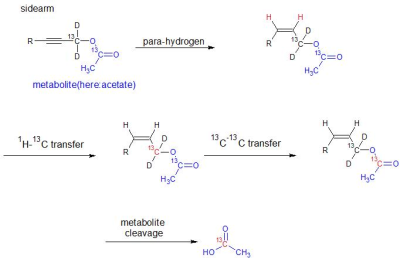 |
19 |
A robust approach to generate high polarization levels of metabolites within seconds with para-hydrogen
Video Permission Withheld
Sergey Korchak, Shengjun Yang, Salvatore Mamone, Stefan Glöggler
Hyperpolarization of metabolites is a promising approach for in vivo disease detection and observation of treatment responses.1-4 Among hyperpolarization techniques, para-hydrogen induced polarization (PHIP) represents an inexpensive approach to generate polarization within a few seconds.5-11 Here, we are introducing a pulsed magnetic resonance method to polarize metabolites that enables us to efficiently transfer proton polarization to a 13C nucleus of interest. This becomes especially possible by attaching an optimized molecular sidearm to a metabolite of choice (here: acetate, glycine and pyruvate) which is para-hydrogenated and the polarization subsequently transferred. We have achieved high levels of metabolite precursor polarization (P >10%) with para-hydrogen within 15 seconds. Cleavage of the sidearm yields hyperpolarized metabolites.
|
|
3572.
 |
20 |
 Hyperpolarization without a polarizer: in vivo 13C-MRI using SAMBADENA Hyperpolarization without a polarizer: in vivo 13C-MRI using SAMBADENA
Andreas Schmidt, Stephan Berner, Moritz Braig, Mirko Zimmermann, Jürgen Hennig, Dominik von Elverfeldt, Jan-Bernd Hövener
Hyperpolarization (HP) enhances the sensitivity of MR by several orders of magnitude and allows the detection of metabolism non-invasively and in vivo. However, well-established methods are costly, complex and require a dedicated “polarizer” next to the MRI system. SAMBADENA is, to date, the simplest and most cost-effective method to generate 13C-HP > 20 % for MRI. Within seconds HP is achieved within the MRI and little additional hardware is required. Here, the first in-vivo applications of SAMBADENA are reported, demonstrating its potential to be a fast, simple, low-cost alternative method for HP-MRI.
|
|
3573.
 |
21 |
 Considerations for Spin Order Transfer to 13C-labeled pyruvate precursors by Parahydrogen-induced Polarization for in vivo applications Considerations for Spin Order Transfer to 13C-labeled pyruvate precursors by Parahydrogen-induced Polarization for in vivo applications
Neil Stewart, Mitsushi Tomohiro, Yoshiki Uchio, Kensuke Takoshima, Shingo Matsumoto
The recent achievement of 13C-pyruvate polarization by side-arm para-hydrogen induced polarization (SA-PHIP) in-vitro has renewed interest in PHIP, which has been limited by a lack of biologically-relevant directly-polarizable compounds. To investigate the achievable polarization of 13C-pyruvate by SA-PHIP for in-vivo metabolic MRI, density matrix simulations of polarization transfer by magnetic field cycling (MFC) and spin-order transfer (SOT) pulse sequences were performed for target precursors. MFC-based approaches were confirmed to be suitable for polarization transfer over the long-range J-couplings present in SA-PHIP precursors. Additionally, simulated polarization levels with SOT approaches were reasonable for representative 13C-pyruvate precursors, promising for metabolic MRI.
|
|
3574.
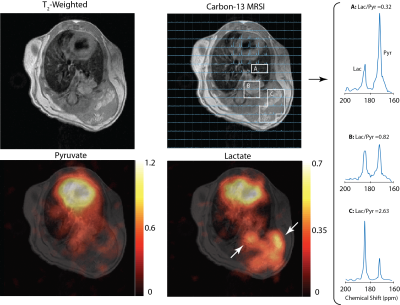 |
22 |
 Feasibility of Imaging Lung Cancer Using Hyperpolarized MRI Technology Feasibility of Imaging Lung Cancer Using Hyperpolarized MRI Technology
Mehrdad Pourfathi, Luis Loza, Stephen Kadlecek, Ian Duncan, Diane Lim, Shampa Chatterjee, Kai Ruppert, Sarmad Siddiqui, Harrilla Profka, Yan Liu, Jessica Kim, Hooman Hamedani, Yi Xin, Faraz Amzajerdian, Maurizio Cereda, Ryan Baron, Mary Spencer, Tahmina Achekzai, Jose Conejo-Garcia, Rahim Rizi
We demonstrate the feasibility of hyperpolarized MRI technology to image lung cancer in mice. We demonstrated the use of 13C MRSI to detect elevated pyruvate to lactate conversion in the tumor relative to the adjacent non-cancerous lung tissue. We also showed the feasibility of 129Xe imaging to detect non-aerated regions in the lung tissue co-localized with the tumor. The utility of these modalities combined may provide a multi-faceted tool to assess tumor's stage and its response to therapy in lung cancer.
|
|
3575.
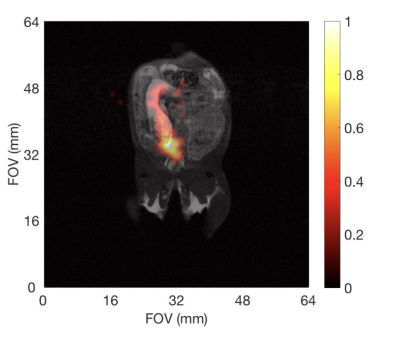 |
23 |
 Improved Hyperpolarization of Solid and Mesoporous Nanoscale Silicon Particles Using TEMPO Radicals Allows In Vivo 29Si MRI Improved Hyperpolarization of Solid and Mesoporous Nanoscale Silicon Particles Using TEMPO Radicals Allows In Vivo 29Si MRI
Nicholas Whiting, Jingzhe Hu, Shivanand Pudakalakatti, Caitlin McCowan, Hyeonglim Seo, Youngbok Lee, Pratip Bhattacharya
Hyperpolarized silicon microparticles have been previously demonstrated as in vivo MRI contrast agents; unfortunately, their large size and decreased mobility present limitations for targeted molecular imaging. While nanoscale silicon particles can also be hyperpolarized, their signal enhancement is typically limited by a low concentration of endogenous electrons. As such, no studies to date have demonstrated in vivo 29Si MRI of hyperpolarized nano-scale silicon. We demonstrate improved 29Si hyperpolarization with the addition of an exogenous radical species to both solid and mesoporous nanoparticle samples (30-300 nm diameter), which increases 29Si hyperpolarization and allows in vivo imaging of silicon nanoparticles.
|
|
3576.
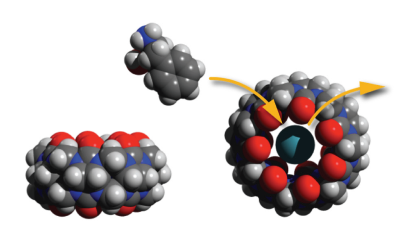 |
24 |
Macrocyclic Xenon hosts: potential inhibitors and reporters for protein aggregation in Hyper-CEST MRI
Video Permission Withheld
Jan Oliver Jost, Christopher Witte, Leif Schröder
Contrast agents for neurodegenerative diseases such as amyloidosis are challenging for MRI due to sensitivity limitations. Using hyperpolarized Xenon with special Xe hosts in combination with chemical excitation saturation transfer (CEST) has the potential to overcome this issue. It has been demonstrated that Cucurbit[7]uril (CB7) is inhibiting the fibrillation of Aβ40/ Aβ42 by interaction with its Phe residues. In parallel, we have demonstrated that CB7 can be used as a Xe-host. Here we present first results for a concept that uses CB7 as a drug and Xe biosensor simultaneously where binding of CB7 to Aβ40 can be detected by changing the Xe-HyperCEST signal.
|
|
Molecular Imaging
Electronic Poster
Molecular Imaging
Monday, 18 June 2018
| Exhibition Hall |
16:15 - 17:15 |
| |
|
Computer # |
|
3577.
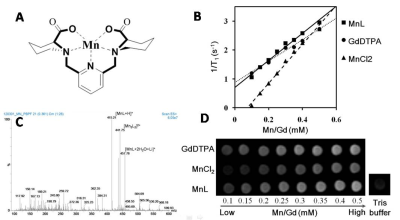 |
25 |
 First-pass Perfusion MRI of Myocardial Infarction Using a Novel Manganese Chelate Contrast Agent in a Rabbit Model First-pass Perfusion MRI of Myocardial Infarction Using a Novel Manganese Chelate Contrast Agent in a Rabbit Model
Lingyi Wen, Zhigang Yang, Hang Fu, Kun Zhang, Ran Sun, Yingkun Guo
First-pass perfusion MRI allows evaluation of myocardial perfusion in myocardial infarction (MI). While Gd3+-based contrast agents are incompatible with renal compromise, we designed and synthesized a novel manganese (Mn2+ ) based contrast agents. MI was induced in 4 rabbits, Mn2+ based and Gd3+-based first-pass perfusion MRI were performed on a 3.0T MRI scanner. All rabbits survived without significant differences in heart rate and left ventricular function. All the perfusion parameters of infarcted and normal myocardial segments correlated well between Gd-based and Mn-based perfusion imaging. Our novel Mn2+ contrast agents is safe and reliable to visualize myocardial perfusion in MI.
|
|
3578.
 |
26 |
Intracellular Assembly of Olsalazine Nanoparticles for CEST MR Imaging and Cancer Therapy
Video Permission Withheld
Yue Yuan, Xiaoliang Qi, Jia Zhang, Xiaolei Song, Michael McMahon, Jeff Bulte
Based on a biocompatible condensation reaction caused by tumor-related proprotein convertase furin, we developed a novel probe RRVR-Olsa for tumor-targeted CEST MR imaging and chemotherapy to accomplish theranostics. Our preliminary studies indicated that, RRVR-Olsa elicited an obvious increase in CEST signal and higher cytotoxicity on furin-overexpressing HCT116 cancer cells than on furin-deficient LoVo cells and on furin inhibitor-treated HCT116 cancer cells. In vivo CEST MRI with the use of RRVR-Olsa could readily distinguish the difference of furin expression in HCT116 tumor and LoVo tumor, which we attributed to the furin-directed intracellular self-assembly of RRVR-Olsa to olsalazine nanoparticles with enhanced accumulation.
|
|
3579.
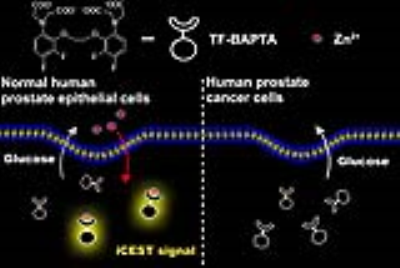 |
27 |
In Vivo iCEST MRI Detection of Zinc Depletion in an Orthotopic Prostate Cancer Mouse Model
Video Permission Withheld
Yue Yuan, Chengyan Chu, Zhiliang Wei, Xiaolei Song, Jeff Bulte
Prostate cancer is the only known disease of the prostate that displays such a substantial decrease in tissue zinc content and neither prostatitis nor benign prostatic hyperplasia are associated with this phenotype. 19F-based iCEST MRI probe TF-BAPTA was used to show clearly a detectable difference in zinc concentration between normal and malignant prostate cell lines, and normal prostate cells with a downregulated ZIP1 transporter. Via an orthotopic prostate cancer mouse model, the feasibility of iCEST MRI to distinguish normal mouse prostate and cancerous prostate has been verified. Hence, iCEST MRI may have potential to non-invasively monitor the early malignant transformation in prostate cancer.
|
|
3580.
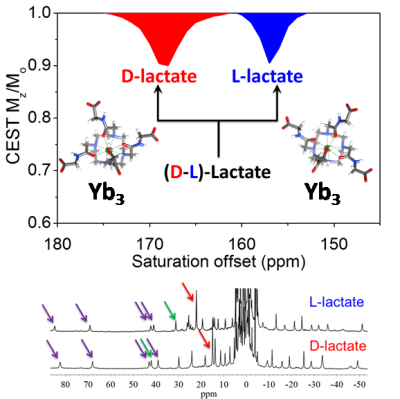 |
28 |
Imaging and discrimination of extracellular lactate in vivo using CEST and a paramagnetic shift reagent
Video Permission Withheld
Andre Martins, Lei Zhang, Veronica Clavijo-Jordan, Alexander Funk, Carlos Platas-Iglesias, A. Dean Sherry
Glucose taken up by cancer cells is thought to be converted largely to lactate even in the presence of abundant oxygen although the amount of pyruvate diverted into the mitochondria is largely unknown. Hence, a method for imaging actual lactate production by tumors could be highly informative. We report in this work the design of several lanthanide-based shift reagents (SR) that form complexes with lactate and shift the lactate –OH CEST signal to a different frequency far away from water. Given that these SR’s are confined to extracellular space, the resulting lactate –OH CEST signal becomes a specific biomarker of lactate exported from cancer cells. This method offers great promise for imaging lactate production by tumors.
|
|
3581.
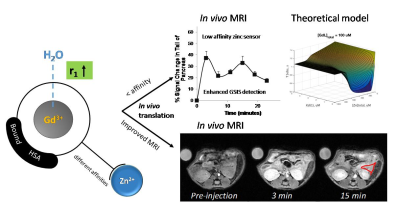 |
29 |
Low affinity zinc sensors for improved MRI detection of glucose-stimulated zinc(II) secretion from pancreatic beta-cells in vivo
Video Permission Withheld
Andre Martins, Veronica Clavijo-Jordan, Sara Chirayil, Shanrong Zhang, Namini Paranawithana, A. Dean Sherry
We report here the design of several gadolinium-based MR contrast agents with different zinc affinities. The zinc sensors increased r1 in the presence of Zn2+ ions and more in the presence of serum albumin, only when zinc was present. The sensors with a lower affinity for Zn2+ enhanced better the MR contrast produced by zinc release in mouse pancreas due to reduced background signal. These lower affinity Zn2+ agents show great promise for detecting and monitoring the pharmacological effect of drugs in diabetes.
|
|
3582.
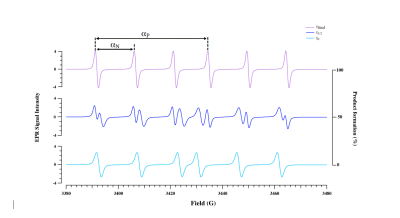 |
30 |
 An Elastase Activity Reporter for EPR and OMRI as a Line-Shifting Nitroxide. An Elastase Activity Reporter for EPR and OMRI as a Line-Shifting Nitroxide.
Natacha Jugniot, Indranil Duttagupta, Angélique Rivot, Philippe Massot, Colleen Cardiet, Jean-Michel Franconi, Pierre Voisin, Elodie Parzy, Eric Thiaudičre, Sylvain R.A Marque, Abderrazzak Bentaher, Gérard Audran, Philippe Mellet
Neutrophils secrete proteases at inflammation sites leading to protease/inhibitor imbalance. Among them, neutrophil elastase (NE) is responsible for lung degradation via elastin fragmentation. Monitoring protease/inhibitor status non-invasively would be an important diagnostic tool. We present Meo-Suc-(Ala)2-Pro-Val-nitroxide, a line-shifting elastase activity probe for Electronic Paramagnetic Resonance (EPR) spectroscopy and Overhauser-enhanced Magnetic Resonance Imaging (OMRI). Fast and sensitive with Km= 15 ± 2.9 µM, kcat/Km= 930000 s-1.M-1, this substrate was assessed with bronchoalveolar lavage samples from Pseudomonas pneumonia mouse model. We observed a clear difference between wild type and NE deficient animals. These results can lead to new in vivo diagnostic methods and lung protection.
|
|
3583.
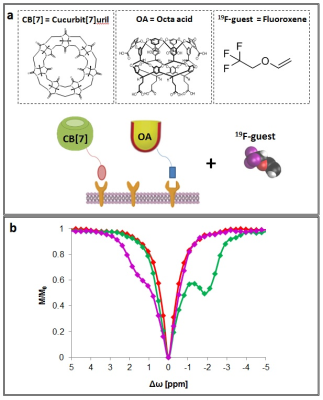 |
31 |
 Using single 19F-probe for multiplexed imaging with 19F-CEST MRI Using single 19F-probe for multiplexed imaging with 19F-CEST MRI
Ronit Shusterman-Krush, Liat Avram, Bruce Gibb, Amnon Bar-Shir
Heteronuclear-CEST imaging presents several unique properties when compared to 1H-CEST, which is based on water, including background-free signals, quantifyability and ability to monitor low concentrations of targets. Here we present the performance of the CEST approach in 19F-MRI framework for mapping multiple targets in a “multicolor” fashion. Specifically, the difference in binding kinetics between a 19F-agent and a molecular target (i.e., macrocyclic molecular host) and the different Δw values obtained in 19F-NMR lead to a clear 19F-CEST characteristics. The large 19F-CEST effect obtained and its Δw dependency allow the mapping of two molecular targets simultaneously using single 19F-probe.
|
|
3584.
 |
32 |
 Calcium-dependent molecular fMRI using a magnetic nanosensor Calcium-dependent molecular fMRI using a magnetic nanosensor
Benjamin Bartelle, Satoshi Okada, Nan Li, Vincent Breton-Provencher, Mriganka Sur, Alan Jasanoff
Superparamagnetic iron oxide nanoparticles are a modular platform technology for sensors with sub nM sensitivity and robust biomedical applications. In this work we engineer nanoparticle sensors that display Ca2+ dependent aggregation and demonstrate the first functional MRI study of Ca2+ dynamics as well as the first in vivodemonstration of a dynamic nanosensor.
|
|
3585.
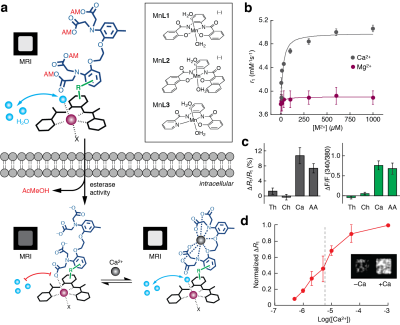 |
33 |
 Sensing intracellular calcium ions using a manganese-based MRI contrast agent Sensing intracellular calcium ions using a manganese-based MRI contrast agent
Benjamin Bartelle, Barandov Ali, Catherine Williamson, Emily Loucks, Alan Jasanoff
Inspired by the classical work of R. Tsien on cell-permeable calcium specific chelators using readily cleavable acetomethoxy esters (AM) of BAPTA and taking advantage of our own, novel, cell permeable manganese-based contrast agent, we developed a new MRI contrast that displays membrane permeability, cellular accumulation via cleavable ester groups, and physiological sensitivity to calcium. With this breakthrough innovation, we present a series of firsts for functional molecular imaging, reporting chemically and optogenetically induced calcium transients with MRI in living cells.
|
|
3586.
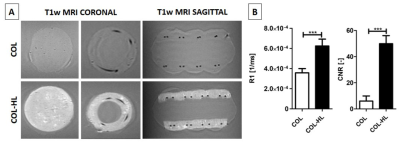 |
34 |
Labelling of collagen type I templates with a novel naturally derived contrast agent for magnetic resonance imaging in soft tissue engineering
Video Permission Withheld
Heinz Peter Janke, Nihan Güvener, Weiqiang Dou, Jozef Cremers, Paul Borm, Wout Feitz, Arend Heerschap, Fabian Kiessling, Egbert Oosterwijk
Contrast agents (CA) need to be applied for monitoring tissue-engineered implants by MR imaging. However, currently used CAs have limitations (i.e. negative contrast, label instability). In this study, Hemin-Lysine complex (HL) -as a naturally derived alternative CA- is used for active labeling of hybrid collagen-based templates. HL-labeled templates are clearly identified because of their bright signal in T1-weighted MR images. The signal of labeled templates and thus their integrity could be followed over time when subcutaneously implanted in a mouse model. Thus, loading collagen-based templates with HL appears to be a promising strategy to localize and monitor its fate upon implantation.
|
|
3587.
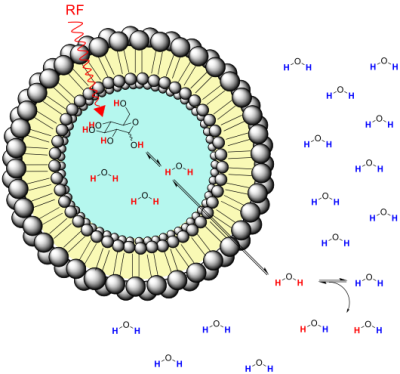 |
35 |
 The effect of liposomal encapsulation on the chemical exchange properties of diamagnetic CEST agents. The effect of liposomal encapsulation on the chemical exchange properties of diamagnetic CEST agents.
Eleni Demetriou, Harriet Story, Robin Bofinger, Helen Hailes, Alethea Tabor, Xavier Golay
Liposome encapsulation of glucose or 2-deoxy-D-glucose (2-DG) may be exploited to enhance the CEST signal by reducing the overall apparent exchange rate. Here we aim to construct a complete theoretical model to measure the exchange properties of diamagnetic CEST agents. Experimentally measured exchange rates of glucose and 2-DG in the liposomal system were found to be reduced by one or two orders of magnitude due to the intermembrane exchange between the intra- and extra-liposomal compartment because of restrictions in water transfer imposed by the lipid membrane. These new theoretical and experimental findings are expected to benefit applications of diamagnetic liposomes to image biological processes.
|
|
3588.
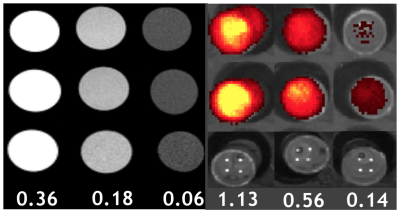 |
36 |
 A mannan-based probe for multimodal imaging of cancer and immune cells A mannan-based probe for multimodal imaging of cancer and immune cells
Daniel Jirak, Andrea Galisova, Marketa Jiratova, Mariia Rabyk, Martin Hruby, Milan Hajek
Presented mannan-based polymers have promising properties for tumor and metastasis imaging due to their biocompatibility, nanosize and specificity for the immune cells. In this study, two mannan-based polymers were tested by multimodal imaging (MRI and fluorescence). The polymers showed superior imaging properties compared to a commercially available contrast agent. FLI signal at the liver and higher signal at the injection site in the mouse with MN-Ox suggested slower elimination process due to addition of polyoxazoline chains in its structure. Both probes were visualized by MR and optical imaging modality at the injection sites and in the lymph nodes of the experimental mice suggesting their promising properties for cancer diagnosis.
|
|
3589.
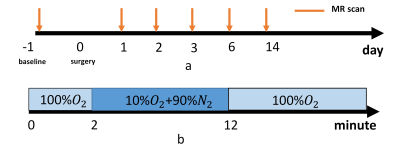 |
37 |
 High Temporal Resolution Dynamic BOLD MRI in Tracking Kidney Response to Hypoxia and Hyperoxia in a Rat AKI model at 7T High Temporal Resolution Dynamic BOLD MRI in Tracking Kidney Response to Hypoxia and Hyperoxia in a Rat AKI model at 7T
Kaixuan Zhao, Yingjie Mei, Guixiang Yang, Yanqiu Feng
Blood oxygenation level-dependent magnetic resonance imaging has shown potential to monitoring the tissue oxygenation. However, the absolute T2* value has shown limited usefulness to surrogate the renal microcirculation. This work we monitor the AKI rat renal response to hypoxia and hyperoxia to tracking the hemodynamic changes in the progress of acute kidney injury.
|
|
3590.
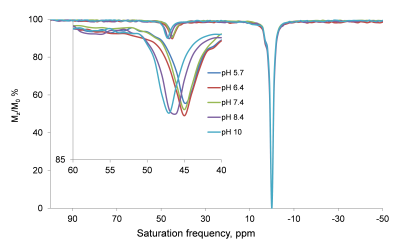 |
38 |
 A new class of pH-responsive paraCEST agents for MRI A new class of pH-responsive paraCEST agents for MRI
James Ratnakar, Sara Chirayil, Alexander Funk, Zoltan Kovacs, A Dean Sherry
Many paraCEST agents have reduced sensitivity in vivo due to the reduction of the T2 relaxation of bulk water by T2ex exchange. Phosphonate coordinating side-chains in cyclen-based complexes exclude inner sphere water and this should reduce the interfering T2ex effects. In the new complexes reported here, a combination of phosphonate and hydroxypropyl pendant arms were incorporated to take advantage of the CEST signal from the Ln-bound OH. Protonation of the coordinating phosphonates results in a shift in the resonance frequency of Ln-bound OH CEST. These agents display several attractive features for imaging tissue pH in vivo by CEST MRI.
|
|
3591.
 |
39 |
Relaxation-compensated multi-pool CEST signal at 7T MRI of WHO IV gliomas is dependent on the anatomic localization
Video Permission Withheld
Constantin Dreher, Johanna Oberhollenzer, Johannes Windschuh, Jan-Eric Meißner, Felix Sahm, Martin Bendszus, Andreas Unterberg, Wolfgang Wick, Peter Bachert, Mark Ladd, Heinz-Peter Schlemmer, Moritz Zaiss, Alexander Radbruch, Daniel Paech
As patients with WHO IV° gliomas are still having a dismal prognosis, further tumor characterization is needed. With prognosis and histopathological parameters being dependent on tumor localization, and Chemical-Exchange-Saturation-Transfer(CEST) MRI at 7T being one of the latest advances in tumor imaging, we have prospectively evaluated CEST signals in 21 patients. Amide CEST and ADC parameters are significantly different with regard to brain hemispheres and correlating. CEST NOE(Nuclear Overhauser-Effect) is not different with regard to brain hemispheres, but in case of contact to the subventricular zone, which is accompanied by worse prognosis. NOE is possibly showing complementary information to Amide CEST.
|
|
3592.
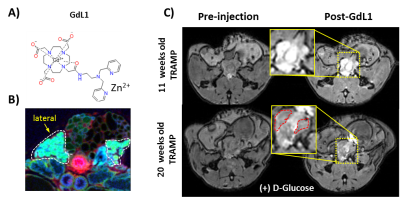 |
40 |
 Detecting prostatic zinc (II) loss in a TRAMP prostate cancer model by glucose-stimulated zinc (II) secretion in vivo with MRI Detecting prostatic zinc (II) loss in a TRAMP prostate cancer model by glucose-stimulated zinc (II) secretion in vivo with MRI
Veronica Clavijo Jordan, Alia Al-Ebraheem, Su-Tang Lo, Tina Geraki, Andre Martins, Sara Chirayil, Neil Rofsky, Michael Farquharson, A. Dean Sherry
We have previously found that glucose stimulates the secretion of zinc stores from epithelial cells in the prostate gland, and that this glucose-stimulated zinc secretion (GSZS) can be detected in vivo by a Gd-based zinc sensor with T1-weighted MRI. Here we elucidate the mechanisms of enhancement in the healthy prostate and loss of enhancement in the malignant prostate by GSZS MRI and Synchrotron-Radiation X-Ray Fluorescence (SR-XRF). GSZS MRI detects the unique loss of zinc content in the lateral lobe of the malignant prostate as observed by SR-XRF with a Gd-based high affinity Zn2+ sensor.
|
|
3593.
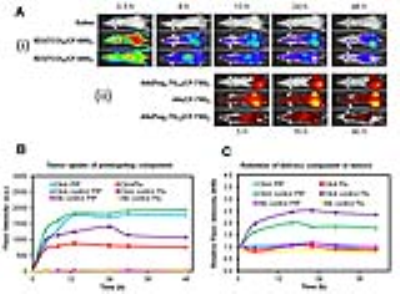 |
41 |
MR and optical imaging study to evaluate effects on bioorthogonal click therapy in prostate cancer mouse models
Video Permission Withheld
Sudath Hapuarachchige, Colin Huang, Jorge Flores, Cyril Barinka, Dmitri Artemov
Click therapy is a new therapeutic strategy for cancers minimizing systemic toxicity and enhancing therapeutic efficacy. For this strategy, slow internalization of pretargeted cell surface receptors gives a sufficient window for clearance of the unbound pretargeting component before administration of delivery components. Here, we tested click therapy in PSMA(+) PC3-PIP and PSMA(-) PC3-Flu (control) tumors to evaluate delivery and internalization of components. We observed that internalization of 5D3 antibody is fast, which may interfere with the delivery of therapeutic components. In large tumors with leaky vasculature, 5D3 antibody can effectively extravasate leading to the cluster formation with delivery component in tumor microenvironment.
|
|
3594.
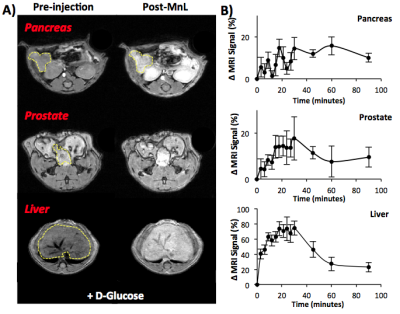 |
42 |
 Imaging glucose-stimulated zinc secretion from the prostate and pancreas using a Mn(II)-based zinc sensor Imaging glucose-stimulated zinc secretion from the prostate and pancreas using a Mn(II)-based zinc sensor
Veronica Clavijo Jordan , Sara Chirayil, Andre Martins, Namini Paranawithana, James Ratnakar, A. Sherry
Imaging glucose-stimulated zinc secretion (GSZS) from secretory tissues has proven useful at assessing organ function and health; current probes to detect zinc secretion by MRI have so far been limited to gadolinium-based sensors. In this work we introduce a manganese-based zinc sensor and show that pancreatic and prostatic zinc detection is not compromised when using Mn instead of Gd for imaging GSZS in vivo. Biodistribution studies indicate that the Mn-based sensor is cleared intact after renal filtration but degraded during hepatobiliary clearance.
|
|
3595.
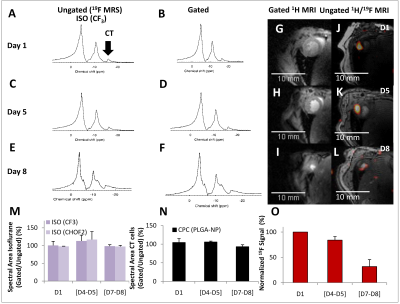 |
43 |
 In Vivo Murine Cardiac 19F MRI and Tracking of PFCE- and FuGENE-labeled Progenitor Stem Cells in the C57BL/6 Mouse In Vivo Murine Cardiac 19F MRI and Tracking of PFCE- and FuGENE-labeled Progenitor Stem Cells in the C57BL/6 Mouse
Chris Constantinides, Ricardo Carnicer Hijazo, Andrew Shaw, Jyoti Patel, Edyta Swider, Mangala Srinivas, Carolyn Carr
Despite advances in the visualization of pre-labeled SCs with perfluorocarbon-ether-nanoparticles (PFCE-NPs) or other MRI contrast agents using 19F MRI, there have been no prior reports on murine cardiac 19F imaging of exogenously administered cardiac SCs following direct, intra-cardiac injections. To-this-date, human or murine in vivo cardiac studies have been limited, while prior reported imaging attempts in rats have been prohibitively lengthy, costly (use of multiple millions of cells/animal), and practically complex to reproduce in mice. We report herein significant enhancements of PFCE-NP label following labeling with the highly efficient agent FuGENE, thereby allowing in vivo murine cardiac 19F MRI visualization with minimal cellular toxicity.
|
|
3596.
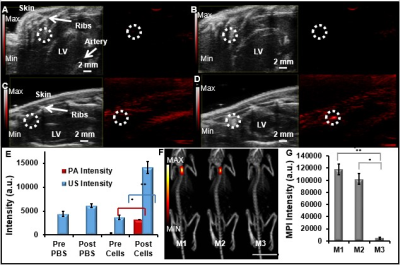 |
44 |
 A Triple Modality Contrast Agent for Acoustic and Magnetic Particle Imaging (MPI) of Stem Cells A Triple Modality Contrast Agent for Acoustic and Magnetic Particle Imaging (MPI) of Stem Cells
Jeanne Lemaster, Fang Chen, Taeho Kim, Jesse Jokerst
Magnetic particle imaging is a novel and background-free imaging technique that offers good depth of penetration and high contrast of iron oxide nanoparticle tracers. Here, we combined MPI with acoustic imaging through multimodal polymeric nanoparticles. We used these nanoparticles for in vivo stem cell tracking.
|
|
3597.
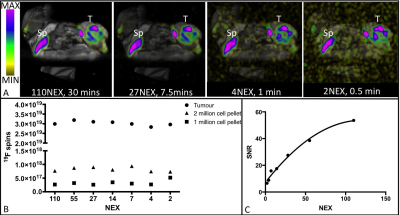 |
45 |
 Translating 19F-based cellular MRI from 9.4T to 3T: Feasibility of future clinical applications Translating 19F-based cellular MRI from 9.4T to 3T: Feasibility of future clinical applications
Ashley Makela, Paula Foster
A limitation of 19F-based MRI is low sensitivity; consequently, many studies have been performed at high field strengths with relatively long scan times (ie. 30 minutes). Because of this, human applications have seemed unreasonable. Here, we investigate the feasibility of translating 19F MRI from 9.4T to a 3T clinical scanner. Upon optimization of 3T scan parameters, 19F image quality was similar and 19F spin quantification was not different to a scan performed at 9.4T. Additionally, a 30 second scan produced the same 19F spin quantification as a 30 minute scan at 3T. These findings show promise for future clinical applications.
|
|
3598.
 |
46 |
 Magnetic Particle Imaging as a tool for cell tracking: filling the voids left by MRI Magnetic Particle Imaging as a tool for cell tracking: filling the voids left by MRI
Ashley Makela, Jeffrey Gaudet, Paula Foster
Magnetic Particle Imaging (MPI) is emerging as a specific, quantitative and sensitive cellular imaging technique. MPI directly detects a SPIO tracer as positive contrast, and this signal is linearly quantifiable with zero tissue attenuation. Because of this, MPI is well suited for in vivo cell tracking to image tumor associated macrophages (TAMs). TAM content can be used as a biomarker to predict tumor growth and metastatic potential. Mice bearing 4T1 and 168FARN tumors were imaged post intravenous SPIO injection to investigate for the first time, the application of MRI and MPI to differentiate between murine cancer models with varying metastatic potentials.
|
|
3599.
 |
47 |
 Novel tracking method for cellular patterns obtained by Laser-Assisted Bioprinting using Magnetic Resonance Imaging Novel tracking method for cellular patterns obtained by Laser-Assisted Bioprinting using Magnetic Resonance Imaging
Olivia Kérourédan, Sylvain Miraux, Raphael Devillard, Emeline Ribot
One major issue of in situ bioprinting is related to cell pattern imaging in vivo. Magnetic Resonance Imaging (MRI) associated with Micron-sized superparamagnetic Iron Oxide (MPIO) particles constitutes a non-invasive method for tracking cells in vivo. In this study, optimal MPIO concentrations for tracking bioprinted cells were determined. Cell densities of patterns and MRI signals were correlated. MRI was used to track cell patterns in vitro and post-mortem, after in situ bioprinting onto a mouse calvaria defect. Results indicate that MRI combined with MPIO cell labeling is a valuable technique to track bioprinted cells with sufficient precision.
|
|
3600.
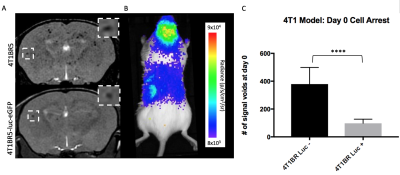 |
48 |
 Cellular MRI reveals altered brain arrest of genetically-engineered reporter-expressing metastatic breast cancer cells Cellular MRI reveals altered brain arrest of genetically-engineered reporter-expressing metastatic breast cancer cells
Katie Parkins, Veronica Dubois, Suzy Wong, Amanda Hamilton, Paula Foster, John Ronald
While BLI is very complementary to MRI in evaluating the fate of many different cell populations in vivo, including cancer cells, some considerations for the use of BLI have been reported including an increase in tumor growth variation as well as a change in metastatic pattern following luciferase tagging. The objective of this work was to use cellular and anatomical MRI to characterize the in vivo growth patterns of naive and lentiviral-engineered brain-seeking breast cancer cell lines co-expressing fluorescent and bioluminescent reporters in the mouse brain.
|
|
MR/PET & Molecular Imaging
Electronic Poster
Molecular Imaging
Monday, 18 June 2018
| Exhibition Hall |
17:15 - 18:15 |
| |
|
Computer # |
|
3673.
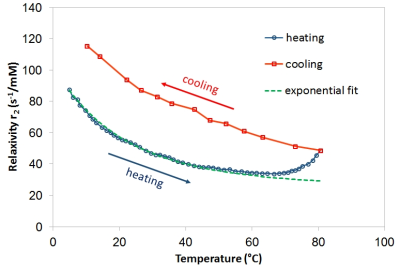 |
1 |
 Stability of silica coating of magnetic nanoparticles for cell tracking Stability of silica coating of magnetic nanoparticles for cell tracking
Vít Herynek, Lenka Kubícková, Ondrej Kaman, Pavel Veverka, Milan Hájek
Magnetic nanoparticles are broadly used for cell tracking in vivo using magnetic resonance imaging. Silica coating, often used for magnetic nanoparticles, represents an inert and stable barrier between the nanoparticle core and cell environment. However, the coating may disintegrate at high temperatures and expose the core. We monitored this process using dynamic relaxometry and confirmed substantial extend of dissolution by transmission electron microscopy. The process probably reflected the equilibrium of solid silica and soluble silicic species in highly dilute suspensions at higher temperature.
|
|
3674.
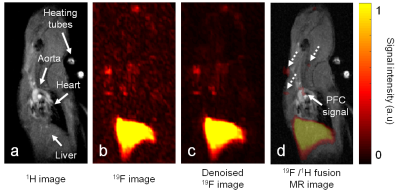 |
2 |
 Optimized Fluorine-19 MRI Quantification and Characterization of Inflammation in Atherosclerotic Plaques in Mice at 3T Optimized Fluorine-19 MRI Quantification and Characterization of Inflammation in Atherosclerotic Plaques in Mice at 3T
Emeline Darçot, Roberto Colotti, Jérôme Yerly, Maxime Pellegrin, Anne Wilson, Stefanie Siegert, Matthias Stuber, Ruud van Heeswijk
Establishing a direct quantification and monitoring of inflammation in diseases such as atherosclerosis in a clinical setting is one of the main goals of fluorine-19 (19F) MRI of perfluorocarbons (PFCs). To this end, with 19F imaging and a denoising algorithm, we demonstrated the feasibility of quantitative 19F MRI in small inflammation sites such as atherosclerotic plaques in mice at 3T (average PFCs concentration per plaque=0.49±0.10mM; average plaque volume=2.8±1.1mm3). In a second step, with imaging flow cytometry, we characterized and visualized the PFC-incorporating immune cell populations involved in the inflammation process, which were mainly dendritic cells, macrophages and neutrophils (ratio 9:1:1).
|
|
3675.
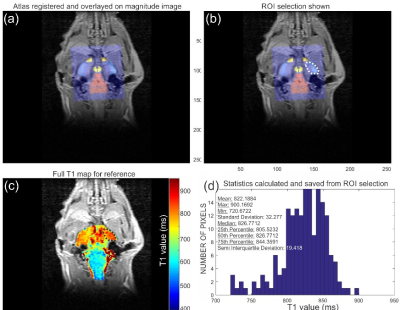 |
3 |
 Contrast Agent Assessment: Comparison of Quantitative Techniques Contrast Agent Assessment: Comparison of Quantitative Techniques
Matthew Tarasek, Jeannette Roberts, Deirdre Cassidy , Jason Castle, Concetta Gringeri, Desmond Yeo, Randall Carter, Brian Bales
Contrast agents are widely used in magnetic resonance imaging (MRI) examinations to enhance the visualization of certain pathologies and anatomical structures to improve diagnostic accuracy. Contrast agents shorten the longitudinal relaxation time (T1) of water molecules, and subsequent signal enhancement in T1-weighted (T1W) images can be observed. In this work, we compare quantitative T1W imaging and T1 mapping for detection of contrast agent deposition in select rat brain structures. Results are presented for two distinct brain structures in a cohort of six rats: three saline controls and three injected with manganese chloride contrast agent.
|
|
3676.
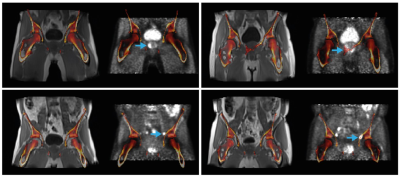 |
4 |
 Including bone in DIXON-based PET/MRI attenuation correction for primary and recurrent prostate cancer Including bone in DIXON-based PET/MRI attenuation correction for primary and recurrent prostate cancer
Mattijs Elschot, Kirsten Selnćs, Hĺkon Johansen, Brage Krüger-Stokke, Helena Bertilsson, Tone Bathen
Accurate correction for bone attenuation may be important for PET/MRI of prostate cancer due to the high bone-density of the pelvis. In this study we evaluated a previously proposed method that includes bone attenuation coefficients in the DIXON-based attenuation map by co-registration with an atlas of the major bones in the body. We found that the inclusion of bone significantly increased the standardized uptake values of soft tissue lesions, but the effect was only in the order of 3%. In addition, we observed that bone registration errors were present near 31% of the lesions, which may hamper widespread clinical applicability.
|
|
3677.
 |
5 |
 Automated tumour definition in diffusion imaging from Gaussian mixture modelling of intrinsically-registered PET data in breast cancer: pilot study Automated tumour definition in diffusion imaging from Gaussian mixture modelling of intrinsically-registered PET data in breast cancer: pilot study
Maren Andreassen, Tone Bathen, Pĺl Erik Goa, Steinar Lundgren, Roja Hedayati, Torill Sjřbakk, Hans Petter Eikesdal, Neil Jerome
Simultaneous positron emission tomography and magnetic resonance imaging (PET/MRI) is an emerging technique in breast cancer practice, allowing collection of morphologic parameters in addition to real-time metabolism. Though feasibility has been demonstrated, the best approach to utilize PET/MRI has not yet been validated. This study focus on evaluating a Gaussian mixture model (GMM) based segmentation technique from PET images with intrinsic MRI registration as a proxy for regions-of-interest (ROIs) manually drawn on post contrast images. The application of the method has been evaluated in a neoadjuvant treatment response assessment setting using apparent diffusion coefficient (ADC) values.
|
|
3678.
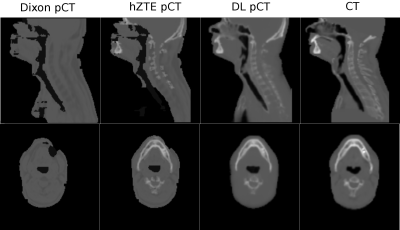 |
6 |
Learning-based attenuation correction for Head and Neck PET/MR
Video Permission Withheld
Maya Khalifé, Romain de Laroche, Sandeep Kaushik, Brian Sgard, Fernando Pérez-García, Melika Sahli Amor, Didier Dormont, Marie-Odile Habert, Florian Wiesinger, Aurélie Kas
PET/MR in head and neck cancer lacks accurate attenuation correction (AC). In this work we implemented and tested three PET/MR-AC methods: 1) Dixon-based AC as used in clinical routine ignoring facial and cervical bones (Dixon), 2) Zero TE (ZTE)-based AC for segmenting bone and combined with Dixon-based fat-water separation (hZTE), 3) a deep learning approach (DL), trained on CT-ZTE datasets. PET images were reconstructed on six patients testing three AC methods (Dixon, hZTE, DL) and compared to reference CT-AC. PET comparison showed underestimated SUV with Dixon-AC, decreased error with hZTE-AC compared to CT-AC and the lowest error with DL-AC.
|
|
3679.
 |
7 |
 Evaluation of Diagnostic Accuracy of Gallium-68 DOTATATE PET-MRI Hybrid Imaging in Staging and Restaging Neuroendocrine Tumors Evaluation of Diagnostic Accuracy of Gallium-68 DOTATATE PET-MRI Hybrid Imaging in Staging and Restaging Neuroendocrine Tumors
James Bai, Robert Matthews, Kavitha Yaddanapudi, Rao Chimpiri, Dinko Franceschi
The purpose of our study is to evaluate diagnostic accuracy of DOTATATE PET-MR hybrid imaging in detecting neuroendocrine tumor. We demonstrated Ga-68 PET-MRI has high accuracy in detection of NET in the abdomen and pelvis. Lesion characterization with combined MRI helps to distinguish benign lesions from malignant ones.
|
|
3680.
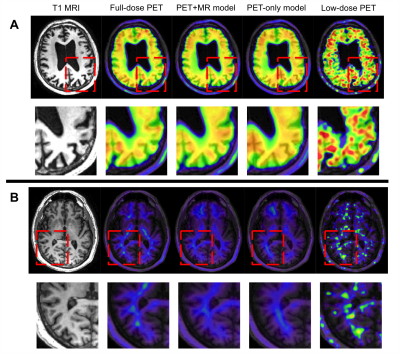 |
8 |
 Ultra-low-dose Amyloid PET Reconstruction using Deep Learning with Multi-contrast MRI Inputs Ultra-low-dose Amyloid PET Reconstruction using Deep Learning with Multi-contrast MRI Inputs
Kevin Chen, Enhao Gong, Fabiola Bezerra de Carvalho Macruz, Junshen Xu, Mehdi Khalighi, John Pauly, Greg Zaharchuk
Simultaneous PET/MRI is a powerful hybrid imaging modality that allows for perfectly correlated morphological and functional information. With deep learning methods, we propose to use multiple MR images and a noisy, ultra-low-dose amyloid PET image to synthesize a diagnostic-quality PET image resembling that acquired with typical injected dose. This technique can potentially increase the utility of hybrid amyloid PET/MR imaging in clinical diagnoses and longitudinal studies.
|
|
3681.
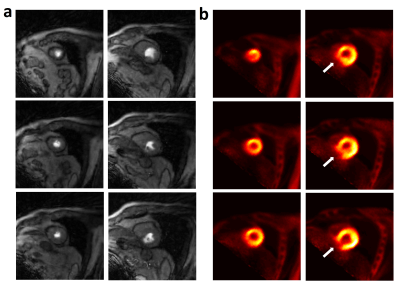 |
9 |
 Radial MS-CAIPIRINHA Efficiently Extends the Anatomical Coverage in MR Myocardial Perfusion Studies on MR-PET Systems Radial MS-CAIPIRINHA Efficiently Extends the Anatomical Coverage in MR Myocardial Perfusion Studies on MR-PET Systems
Tobias Wech, Karl Kunze, Christoph Rischpler, Daniel Stäb, Peter Speier, Herbert Köstler, Stephan Nekolla
Integrated MR-PET imaging is a versatile tool for the non-invasive characterization of cardiovascular disease. In this work, we developed an MS-CAIPIRINHA-based imaging technique to extend the anatomical coverage of the MRI perfusion assessment to six slices per RR. As a proof of principle, the described approach was combined with simultaneous 18F-FDG viability imaging and Late Gadolinium Enhancement (LGE) imaging investigating improvements in anatomical coverage for a relevant patient cohort.
|
|
3682.
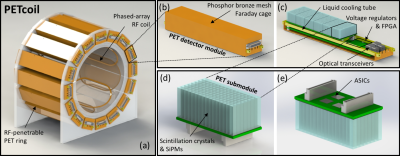 |
10 |
 PETcoil: Elements of an RF-penetrable positron emission tomography insert for simultaneous PET/MRI PETcoil: Elements of an RF-penetrable positron emission tomography insert for simultaneous PET/MRI
Brian Lee, Chen-Ming Chang, Ilaria Sacco, Ronald Watkins, Craig Levin
A PET insert dedicated to brain PET/MRI offers several advantages compared to the commercial integrated whole-body PET/MRI systems, including better sensitivity, spatial resolution, and significantly lower price. We are developing an RF-penetrable PET insert integrated with a custom RX-only phased-array coil, termed collectively as “PETcoil”, dedicated for brain PET/MRI (30 cm diameter, 16 cm axial FOV). In this presentation, we will present the design and preliminary results of the PETcoil with regards to minimizing mutual interference between the PET and MRI while maintaining excellent performance.
|
|
3683.
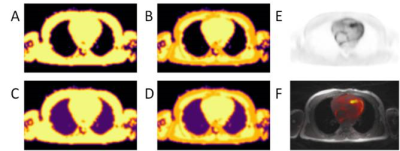 |
11 |
 Optimization of MR-Based Attenuation Correction for Cardiac PET/MR Using Free-Breathing Multi-Echo Golden-Angle Radial Stack-of-Stars MR Optimization of MR-Based Attenuation Correction for Cardiac PET/MR Using Free-Breathing Multi-Echo Golden-Angle Radial Stack-of-Stars MR
Philip Robson, Thomas Benkert, MariaGiovanna Trivieri, Nicolas Karakatsanis, Ronan Abgral, Marc Dweck, Jason Kovacic, Tobias Block, Zahi Fayad
Recently hybrid PET/MR has gained much interest for its potential to combine PET imaging of disease activity with the benefits of cardiac MR. MR-based attenuation correction (MRAC) is an important aspect of accurate PET tracer quantification. For imaging the heart, optimal MRAC is required to both compensate for cardiac motion and also to optimize segmentation of tissues for accurate PET reconstruction. In this work we investigate the use of multi-echo golden-angle radial stack-of-stars MR to combine these 2 key attributes.
|
|
3684.
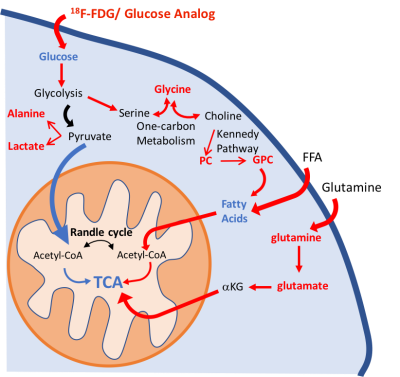 |
12 |
 Metabolic reprogramming in the heart and lung in a murine model of pulmonary arterial hypertension Metabolic reprogramming in the heart and lung in a murine model of pulmonary arterial hypertension
Jose Izquierdo-Garcia, Teresa Arias, Yeny Rojas, Jesus Ruiz-Cabello
Pulmonary Arterial Hypertension is a rare disease of the pulmonary circulation that produces narrowing of small pulmonary arteries, increasing of pulmonary vascular resistance and right ventricular failure. We studied the associated metabolic reprogramming in lung and heart tissues, which is essential for disease progression, in a mouse model of hypoxia induced PAH. Lung and heart metabolism were monitored by HR-MAS NMR spectroscopy and PET imaging. We identified an alteration in energetic and proliferative metabolism of the lungs. We also found a shift in energy metabolism in cardiac tissue.
|
|
3685.
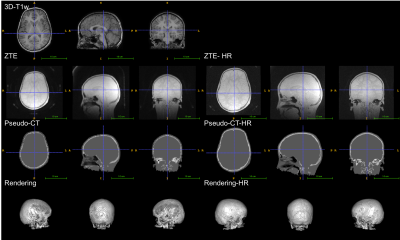 |
13 |
 Applications of ZTE-derived Attenuation Correction Maps to Neuropediatric Cases: A Preliminary Analysis Applications of ZTE-derived Attenuation Correction Maps to Neuropediatric Cases: A Preliminary Analysis
Brice Fernandez, Gaspar Delso, Gisčle Depas, Maya Khalifé, Irčne Buvat, Claude Comtat, Catherine Chiron
PET/MR is a promising imaging modality for pediatric applications due to its lower radiation dose compared to PET/CT. However, commonly implemented MR-derived Attenuation Correction (MRAC) methods have not been fully evaluated for pediatrics brain applications. Consequently, we aimed at comparing different MRAC methods (Atlas, ZTE and High-resolution ZTE) on pediatric patients. Since the current gold standard AC data (i.e. CT) is missing, the different MRAC methods are ranked in comparison with the results found in the literature to determine if current knowledge regarding MRAC methods applied on adults might be extended to the considered pediatric population.
|
|
3686.
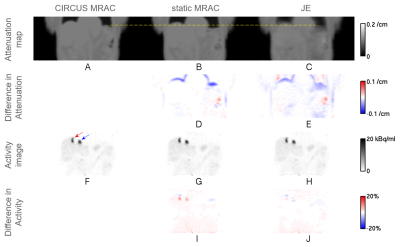 |
14 |
 Joint estimation applied to attenuation correction for quiescent period respiratory gated PET data in PET/MR Joint estimation applied to attenuation correction for quiescent period respiratory gated PET data in PET/MR
Sangtae Ahn, Jaewon Yang, Jing Liu, Youngho Seo, Thomas Hope, Peder Larson, Florian Wiesinger
Quiescent period gating of PET data reduces respiratory motion artifacts in PET imaging. However, a respiratory phase mismatch between attenuation map and gated PET data results in PET quantitation errors particularly for lesions in the dome of the liver. To address the problem, we apply a joint estimation (JE) technique to attenuation correction for respiratory phase gated PET data. We demonstrate on clinical PET/MR data that the JE method improves PET quantitation accuracy without an additional process of respiratory phase gating of MR data. JE has additional potential to estimate patient-specific lung tissue density and provide robustness to metallic implants.
|
|
3687.
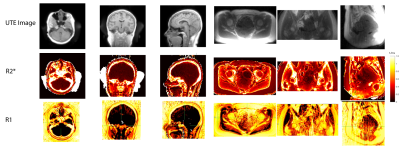 |
15 |
 Quantitative Imaging for Development of PET/MRI phantoms Quantitative Imaging for Development of PET/MRI phantoms
Peder Larson, Misung Han, Peng Cao, Hongyu An, Kathryn Fowler, Kathryn Keenan, Karl Stupic, Richard Laforest, Thomas Hope
This project aims to develop PET/MR phantoms to evaluate MR-based attenuation correction (MRAC) methods and allow standardization of PET results across PET/MRI scanners. This will be accomplished using quantitative ultrashort echo-time (UTE) imaging methods for measurement of T1, T2* and proton density of in vivo tissue types and candidate phantom materials, along with CT measurements of attenuation coefficients. UTE methods are required to characterize bone and choose bone mimics, as this is the most challenging tissue type for MRAC methods to capture.
|
|
3688.
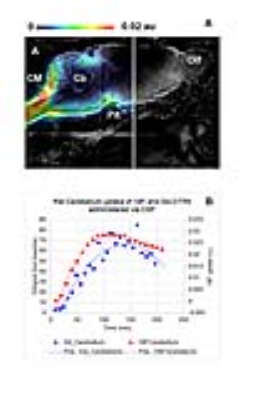 |
16 |
 CSF transport of 18F and 18FDG via the brain-wide glymphatic pathway visualized by Integrative PET-MRI CSF transport of 18F and 18FDG via the brain-wide glymphatic pathway visualized by Integrative PET-MRI
Helene Benveniste, Hedok Lee, Michael Budassi, S. Smith, Mark Schweitzer, Nora Volkow, Maiken Nedergaard, Paul Vaska
The glymphatic pathway was recently re-discovered as a CSF transport system for brain waste removal. The peri-vascular space functions as the ”front end” for toxic waste clearance via the ‘glymphatic pathway. To facilitate future translation to the clinic we executed experiments to map glymphatic transport in the live rodent brain using dynamic integrated MRI-PET imaging in combination with CSF administration of a paramagnetic contrast agent and two different 18F-labeled radioisotopes.
|
|
3689.
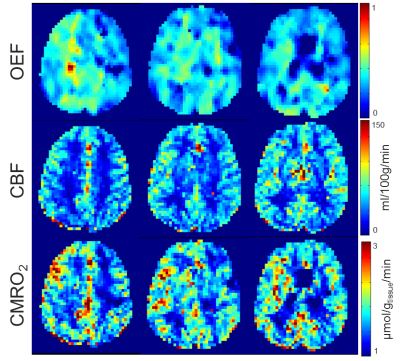 |
17 |
 Quantification of Oxygen Metabolism in Human Brain: Comparison of Direct 17O with Indirect 1H MR Method Quantification of Oxygen Metabolism in Human Brain: Comparison of Direct 17O with Indirect 1H MR Method
Dmitry Kurzhunov, Jan Sedlacik, Robert Borowiak, Divya Bolar, Johannes Fischer, Ali Özen, Michael Bock
In this study, quantification of the cerebral metabolic rate of oxygen consumption (CMRO2) in human brain using direct dynamic 17O-MRI with inhalation of 17O gas was compared to indirect 1H-MRI using QUantitative Imaging of eXtraction of Oxygen and TIssue Consumption (QUIXOTIC) method. The CMRO2 results of both methods are in a good agreement with 15O-PET studies (17O-MRI: 0.83–1.09/1.13–1.48 µmol/gtissue/min in WM/GM regions; 1H-MRI: 0.40–1.45/0.74–1.73 µmol/gtissue/min in WM/GM regions). QUIXOTIC offers smaller pixels which also results in a higher variation of CMRO2 values, whereas MRI with the intracellular tracer 17O provides averaged values with less variation due to the lower spatial resolution.
|
|
3690.
 |
18 |
 Robust MR-based attenuation correction for PET near metal implants Robust MR-based attenuation correction for PET near metal implants
Daehyun Yoon, Mohammad Khalighi, Xinwei Shi, Harsh Gandhi, Dawn Holley, Sandip Biswal, Brian Hargreaves
In simultaneous PET/MRI, the reconstruction of PET image uses an MRI-based attenuation coefficient (AC) map for accurate quantization of radiotracer activity. The AC map is typically derived from SPGR images, but these are severely distorted near metallic implants due to strong off-resonance artifacts. We investigated the influence of the metal artifacts in the MR-based AC map upon the PET image accuracy. To correct the metal artifacts in PET, we present the use of multi-spectral imaging with field-map-based determination of meta boundary and type. Our correction result mitigated the signal underestimation near metal in PET images from 50% to 8%.
|
|
3691.
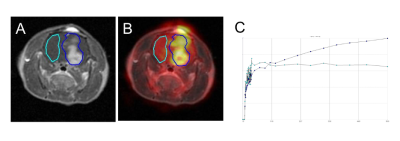 |
19 |
Metabolic Interactions of Simultaneous 18F-FDG PET and Hyperpolarized 13C MRI
Video Permission Withheld
Mette Lauritzen, Milton Merchant, Taichang Jang, Keshav Datta, Ralph Hurd, Shie-Chau Liu, Jae Mo Park, Lawrence Recht, Daniel Spielman
Simultaneous hyperpolarized 13C-pyruvate MRI and 18F-FDG PET imaging have the several potential applications, especially for understanding the complex metabolic processes of cancer. However, we hypothesized the relatively high concentrations of 13C-pyruvate used in hyperpolarized MRI could interfere with the 18F-FDG uptake when administrated simultaneously, because their metabolic products compete for the same pathways. In this study, we examined the effect of injected pyruvate and lactate on 18F-FDG uptake in healthy rats and in rats with implanted C6 gliomas, and discuss the metabolic interactions observed.
|
|
3692.
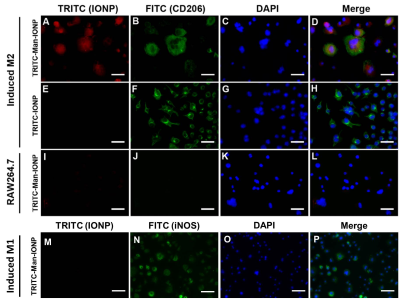 |
20 |
 M2 Tumor Associated Macrophage Targeted Magnetic Resonance Imaging Using Mannose Conjugated Anti-Biofouling Iron Oxide Nanoparticle Probes M2 Tumor Associated Macrophage Targeted Magnetic Resonance Imaging Using Mannose Conjugated Anti-Biofouling Iron Oxide Nanoparticle Probes
Yuancheng Li, Liya Wang, Hui Wu, Weiping Qian, Bing Ji, Lily Yang, Hui Mao
By reducing non-specific macrophage uptake, anti-biofouling polymer coated iron oxide nanoparticles (IONPs) conjugated with mannose as the ligand (Man-IONP) was developed for specifically targeting sub-type tumor associated macrophage M2 with mannose receptor 1 expression. This novel MRI probe demonstrated specific M2 macrophage targeting in vitro with M1 and R264.7 macrophages as controls. Immuno-staining of 4T1 breast tumor tissues with Man-IONPs showed the probe targeting M2 similarly to anti-CD206 antibody. NIR and MR imaging of 4T1 tumor-bearing mice showed significant contrast changes after receiving i.v. injection of NIR dye labeled Man-IONP, while little change was observed for mice receiving non-targeted IONP.
|
|
3693.
 |
21 |
 Manganese Complex of EDTA-Ethoxybenzyl Conjugate as a New Hepatobiliary MRI Contrast Agent Manganese Complex of EDTA-Ethoxybenzyl Conjugate as a New Hepatobiliary MRI Contrast Agent
Md Kamrul Islam, Soyeon Kim, Hee-Kyung Kim, Garam Choi, Ah Rum Baek, Taekwan Lee, DongKyu Kim, Hoe Su Jung, Yongmin Chang
The purpose of the current study is to design and synthesis of novel Mn2+ complex as an alternative to well-established Gd3+ chelates for use as a liver-targeting MR imaging agent. This new complex exhibits high R1 relaxivity (2.3 mM−1 s−1) than clinically approved Mn-DPDP® (1.6 mM−1 s−1) at 1.5 T. It is also kinetically much inert than that of Magnevist®. In vivo MRI enhancement pattern compares well with those of liver-specific MRI CAs such as Primovist® and Multihance®. It shows greater tumor detection in a liver tumor model with negligible toxicity in a clinical dose.
|
|
3694.
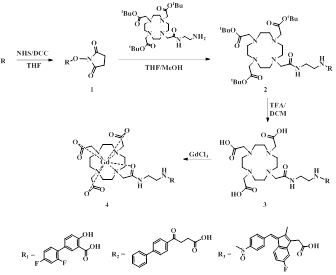 |
22 |
 Gadolinium complexes conjugated with nonsteroidal anti-inflammatory drugs (NSAIDs) as potential inflammation targeting MRI contrast agents. Gadolinium complexes conjugated with nonsteroidal anti-inflammatory drugs (NSAIDs) as potential inflammation targeting MRI contrast agents.
Heekyung Kim, Bokyung Sung, Soyeon Kim, Garam Choi, Ah Rum Baek, Md Kamrul Islam, Taekwan Lee, DongKyu Kim, Hoe Su Jung, Yongmin Chang
Inflammation targeting MR CAs conjugated with NSAIDs were prepared according to the general synthetic methods, and characterized by spectroscopic analysis. The relaxivities of theses gadolinium complexes are slightly higher than those of Gadovist®. From in vivo T1-weighted MR images, strong enhancement was observed in the inflammatory region. Also our new gadolinium complexes represent high kinetic inertness in chemically competitive environment compared with other clinically used MR CAs.
|
|
3695.
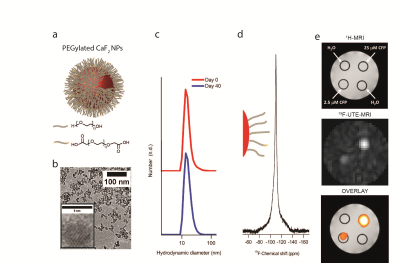 |
23 |
 Small CaF2 nanocrystals as nano-sized tracers for in vivo 19F-MRI Small CaF2 nanocrystals as nano-sized tracers for in vivo 19F-MRI
Idan Ashur, Hyla Allouche-Arnon, Amnon Bar-Shir
In this study we present a novel class of 19F-nanoformulations based on small (<10 nm) fluoride-nanocrystals (specifically CaF2 nanofluorides) for MRI applications. We show that homonuclear dipolar interactions can be averaged out by the fast tumbling of the PEG-coated nanocrystals thus enabling the acquisition of high-resolution 19F-NMR. Using this feature, we demonstrate that our newly developed nanofluorides could be used as 19F-MRI tracers and present a “hot-spot” mapping in an animal model inflammation. The proposed nanofluorides combine the advantages of using nanocrystals (small, high 19F-equivalency, maximal 19F-density, and surface modifiability) with the merits of 19F-MRI tracers.
|
|
3696.
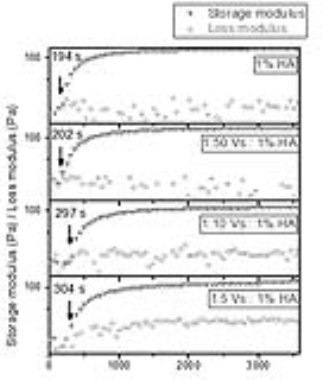 |
24 |
Fluorine labeling and imaging of biomaterial scaffolds for regenerative medicine
Did Not Present
Marcin Piejko, Piotr Walczak, Xiaowei Li, Jeff Bulte, Miroslaw Janowski
There is growing interest in stem cell-based regenerative medicine. Hydrogels can serve as injectable scaffolds for transplanted stem cells in order to provide mechanical support, as well as to mimic natural 3D tissue composition, while allowing for minimally invasive needle- or catheter-based delivery. However, the precision of hydrogel injections, as well as monitoring of gel biodegradation, remains challenging. We have shown that clinical grade fluorine nanoemulsion effectively and firmly labels hyaluronian-based hydrogel, supports survival of embedded stem cells, while only mildly changing rheological properties. Additionally, 19F MRI is very attractive as it does not interfere with anatomical and functional MRI.
|
|
Hyperpolarisation: Applications
Electronic Poster
Molecular Imaging
Monday, 18 June 2018
| Exhibition Hall |
17:15 - 18:15 |
| |
|
Computer # |
|
3697.
 |
25 |
 Toward investigating cerebral metabolism using hyperpolarized pyruvate on a human 7T system Toward investigating cerebral metabolism using hyperpolarized pyruvate on a human 7T system
Sergey Cheshkov, Edward Hackett, Richard Martin, Sandeep Ganji, Ivan Dimitrov, Jae Mo Park
Advances in hyperpolarized MR technology and pre-clinical investigations have recently led to translational studies using clinical 3T human systems. While hyperpolarization provides large increase in MR sensitivity, spectral dispersion at 3T is limited which makes assessment of various metabolic pathways difficult. This work demonstrates the feasibility of using hyperpolarized 13C-pyruvate to study brain metabolism in a whole-body human 7T system. In particular, the benefit of increased chemical shift dispersion and 1H-decoupling were tested in phantom and rat brains in vivo using hyperpolarized [1-13C]- and [2-13C]-labeled pyruvate. Longitudinal relaxation times of these hyperpolarized substrates at 7T are also reported.
|
|
3698.
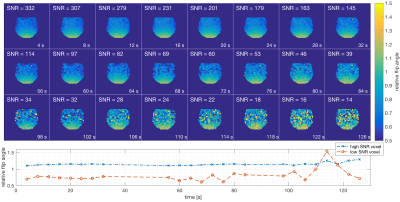 |
26 |
 Integrated B1+ Mapping for Hyperpolarized 13C MRI in a Clinical Setup using Multi-Channel Receive Arrays Integrated B1+ Mapping for Hyperpolarized 13C MRI in a Clinical Setup using Multi-Channel Receive Arrays
Rie Hansen, Peter Shin, Jeremy Gordon, Mark Van Criekinge, Lucas Carvajal, Lars Hanson, Jan Ardenkjćr-Larsen, Daniel Vigneron
For hyperpolarized 13C MRI acquisitions aimed at metabolic rate constant estimation, the Bloch-Siegert shift enables encoding of the transmit field (B1+-field) amplitude within a single hyperpolarized substrate injection. This ability is needed since most clinical hyperpolarized MRI studies use inhomogeneous transmit coils, and because kinetic modeling based on incorrect flip angles can lead to incorrect rate constant estimations. This study demonstrates the feasibility of integrated B1+ mapping for large volume thermal and hyperpolarized phantoms in a clinical setup using a clamshell transmit coil and a 16-channel receive array, and a 3D stack-of-spirals sequence. Phase-sensitive coil-combination was achieved using ESPIRiT.
|
|
3699.
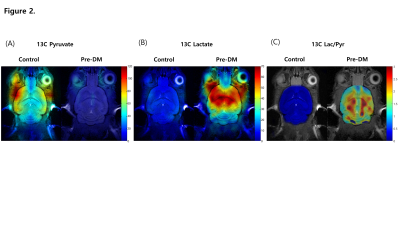 |
27 |
Hyperpolarized [1-13C]pyruvate MRS detects dynamic glucose metabolism according to stages of diabetes in mouse model
Video Permission Withheld
Young-suk Choi, Somang Kang, Hansol Lee, Jae Eun Song, Dong-Hyun Kim, Jong Eun Lee, Ho-Taek Song
Recently, diabetes has been suggested as a risk factor for inducing cognitive impairment. Thus, a quantitative imaging method to validate the metabolic status of the brain according to the stages of diabetes may help elucidate the relationship between the development of cognitive impairment and glucose metabolism of the brain. This study performed hyperpolarized [1-13C]pyruvate imaging in the brain of both pre-diabetes (Pre-DM) and type 2 diabetes (T2DM) mouse model. It shows dynamic brain glucose metabolism according to the stages of diabetes with excellent sensitivity.
|
|
3700.
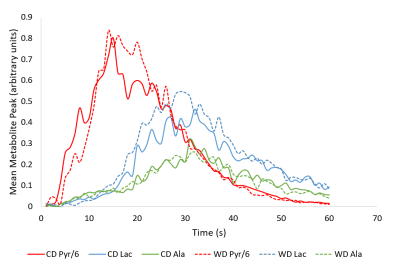 |
28 |
 Hyperpolarized carbon-13 MRS of liver in a high-fat/high sugar diet guinea pig model Hyperpolarized carbon-13 MRS of liver in a high-fat/high sugar diet guinea pig model
Lauren Smith, Lanette Friesen-Waldner, Kevin Sinclair, Trevor Wade, Timothy Regnault, Charles McKenzie
Effects of a life long high-fat/high sugar diet (Western diet: WD) upon pyruvate liver metabolism were observed in a group of young adult male guinea pigs (N=26). Proton density fat-fraction images were reconstructed using IDEAL water fat separation. Metabolism data were obtained using dynamic spectroscopy of hyperpolarized carbon-13 enriched pyruvate. Guinea pigs fed a life long WD displayed a significantly higher hepatic fat fraction and a delayed time to peak for the conversion of pyruvate to lactate. These results indicate that life long consumption of a WD in growing animals is associated with markers of dysfunctional hepatic metabolic function.
|
|
3701.
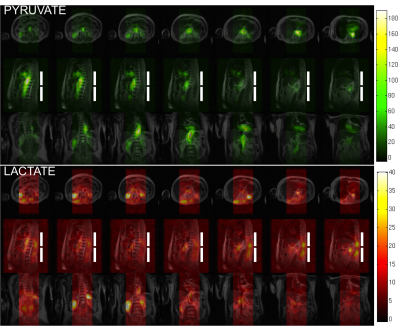 |
29 |
 Case Report: Hyperpolarized 13C Metabolic Imaging of a Castration-Resistant Prostate Cancer Patient Case Report: Hyperpolarized 13C Metabolic Imaging of a Castration-Resistant Prostate Cancer Patient
Casey Lee, Benjamin Geraghty, Justin Lau, Albert Chen, William Perks, Masoom Haider, Urban Emmenegger, Charles Cunningham
The feasibility of applying hyperpolarized 13C MRI to acquire metabolic (lactate, pyruvate) images of the vertebral region of a castration-resistant prostate cancer patient was investigated in this pilot study. The lactate and pyruvate signal-to-noise ratios (SNRs) of spine, back muscle, aorta, and kidney are reported. The summary of patient’s clinical history is illustrated to aid the understanding of implications of 13C-lactate signals observed in this study.
|
|
3702.
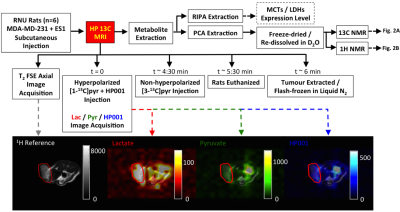 |
30 |
 Correlation Between Hyperpolarized 13C-signal and Lactate Concentration in a Human Breast Cancer Xenograft Model Correlation Between Hyperpolarized 13C-signal and Lactate Concentration in a Human Breast Cancer Xenograft Model
Casey Lee, Benjamin Geraghty, Justin Lau, Albert Chen, Yi-Ping Gu, Charles Cunningham
Hyperpolarized 13C MRI has enabled metabolic (lactate- and pyruvate-) imaging in various clinical and pre-clinical studies to probe the production of lactate in tumours. A number of biological factors has been proposed to influence 13C-signal, with the total lactate pool size thought to be the dominant contributor based on the in vitrocell study by Day et al. In this study, we investigate whether the same relationship holds in a human breast cancer xenograft model in rats, as well as assessing the contributions from other biological components, including the rate of perfusion, transporters, and enzymes.
|
|
3703.
 |
31 |
 Noninvasive assessment of treatment response to histone deacetylase inhibitor and radiation for pediatric diffuse midline glioma using hyperpolarized carbon-13 metabolic imaging Noninvasive assessment of treatment response to histone deacetylase inhibitor and radiation for pediatric diffuse midline glioma using hyperpolarized carbon-13 metabolic imaging
Ilwoo Park, Adam Autry, Xiaodong Yang, Yuying Zhai, Renuka Sriram, Dave Korenchan, John Kurhanewicz, Adam Cunha, I-Chow Hsu, Sabine Mueller
Diffuse midline glioma is one of the most difficult pediatric cancers to treat. This study investigated the feasibility of 13C magnetic resonance metabolic imaging of hyperpolarized [1-13C]pyruvate for monitoring response to novel therapies in diffuse midline glioma. Treatment with panobinostat was associated with a reduction in hyperpolarized lactate and a reduced LDHA activity in an in vitro experiment. Radiotherapy led to a reduction in the ratio of lactate to pyruvate in rats bearing diffuse midline glioma. The results suggest that hyperpolarized 13C metabolic imaging may provide an early noninvasive biomarker to monitor therapy response in diffuse midline glioma.
|
|
3704.
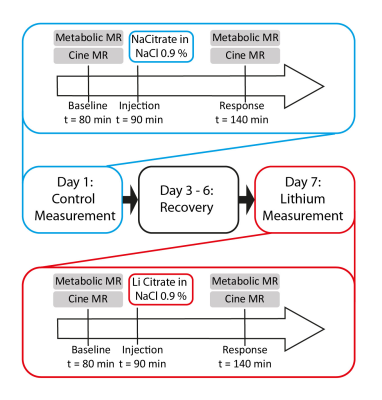 |
32 |
 Establishing a Dose-Response Relationship for Lithium-Induced Modulation of [1-13C]Pyruvate Metabolism in the Heart Establishing a Dose-Response Relationship for Lithium-Induced Modulation of [1-13C]Pyruvate Metabolism in the Heart
Jonas Steinhauser, Patrick Wespi, Grzegorz Kwiatkowski, Sebastian Kozerke
Lithium is the first-line drug used in bipolar disorder, a chronic widespread psychiatric disease. Lithium is a narrow therapeutic index drug and shows cardiac side effects. The present work demonstrates the detectability of lithium induced changes of mitochondrial metabolism in cardiomyocytes using hyperpolarized [1-13C]pyruvate magnetic resonance imaging of the in-vivo rat heart. Metabolic and functional response to lithium was examined for different lithium plasma concentrations.
|
|
3705.
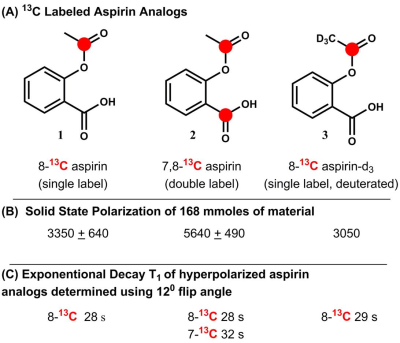 |
33 |
In Vivo Imaging with Hyperpolarized Aspirin
Video Permission Withheld
Argentina Ornelas, Niki Millward, Jaehyuk Lee, Jingzhe Hu, David Menter, Eduardo Vilar Sanchez, Pratip Bhattacharya, Steven Millward
Epidemiological evidence strongly suggests that chronic low-dose aspirin usage leads to a significantly lower incidence of cancer and metastatic disease. Given its emergent role as a chemopreventive, it is highly desirable to develop a method to monitor aspirin pharmacokinetics and metabolism in real time and in vivo. We have recently synthesized and hyperpolarized single and double 13C-labeled aspirin, monitored chemical acetylation in hyperpolarized phantom experiments, and determined metabolism and biodistribution of hyperpolarized 13C aspirin in mice.
|
|
3706.
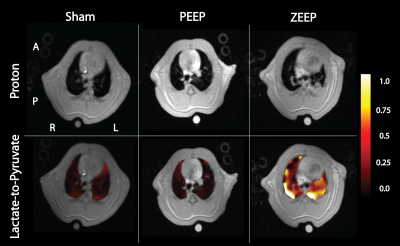 |
34 |
 Pulmonary Metabolism and Inflammation During Mechanical Ventilation: A Hyperpolarized Carbon-13 Study Pulmonary Metabolism and Inflammation During Mechanical Ventilation: A Hyperpolarized Carbon-13 Study
Mehrdad Pourfathi, Shampa Chatterjee, Maurizio Cereda, Yi Xin, Stephen Kadlecek, Hooman Hamedani, Ian Duncan, Sarmad Siddiqui, Harrilla Profka, Kai Ruppert, Luis Loza, Faraz Amzajerdian, Ryan Baron, Mary Spencer, Tahmina Achekzai, Rahim Rizi
We showed that secondary inflammation due to atelectasis increases pulmonary anaerobic metabolism (lactate-to-pyruvate ratio). Recruitment with PEEP limits anaerobic metabolism and contains injury progression. Measuring tissue metabolism with hyperpolarized MRI can disclose novel pathways of tissue damage during lung injury and assess secondary injury progression in ventilated lungs.
|
|
3707.
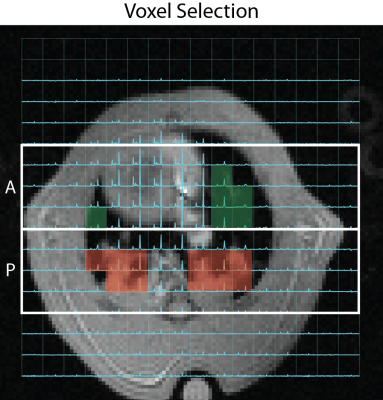 |
35 |
 Imaging Regional Distribution of Metabolic Activity During Progression of Acute Lung Injury using Hyperpolarized Carbon-13 MRI Imaging Regional Distribution of Metabolic Activity During Progression of Acute Lung Injury using Hyperpolarized Carbon-13 MRI
Mehrdad Pourfathi, Maurizio Cereda, Shampa Chatterjee, Yi Xin, Stephen Kadlecek, Hooman Hamedani, Ian Duncan, Sarmad Siddiqui, Harrilla Profka, Kai Ruppert, Luis Loza, Faraz Amzajerdian, Ryan Baron, Mary Spencer, Tahmina Achekzai, Rahim Rizi
We used hyperpolarized [1-13C] pyruvate MRI to assess regional alterations in lactate production during progression of acute lung injury. While the average lactate-to-pyruvate ratio and its standard deviation increased globally in lungs ventilated without recruitment, the average ratio increased more significantly in the posterior regions than the average ratio in the anterior region. The average lactate-to-pyruvate remained unchanged in lungs ventilated with recruitment maneuver. Our finding suggests that stretch-induced atelectasis and inflammation are the root of increased lactate-to-pyruvate ratio in the lungs ventilated without recruitment.
|
|
3708.
 |
36 |
Evaluating hyperpolarized lactate as a theranostic agent for stroke
Video Permission Withheld
Jean-Noël Hyacinthe, Lara Buscemi, Mario Lepore, Rolf Gruetter, Lorenz Hirt, Mor Mishkovsky
Stroke is the leading cause of disability and the third leading cause of death worldwide. Lactate administration into the ischemic brain directly after blood reperfusion was found to be neuroprotective. MR with hyperpolarized (HP) probes enables in vivo real-time measurement of biochemical transformations of HP 13C-labeled precursors, including lactate. The aim of this study was to demonstrate the feasibility of probing HP [1-13C]L-lactate metabolism in mice brain after ischemic stroke, and to study the influence of the time window after reperfusion on its conversion in order to evaluate the potential of HP lactate as a theranostic agent for stroke.
|
|
3709.
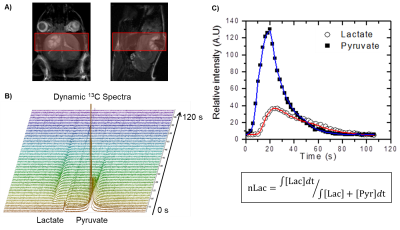 |
37 |
 Imaging metabolic development of patient-derived glioblastoma xenografts in vivo employing hyperpolarized magnetic resonance Imaging metabolic development of patient-derived glioblastoma xenografts in vivo employing hyperpolarized magnetic resonance
Travis Salzillo, Joy Gumin, Jaehyuk Lee, Islam Hassan, Niki Zacharias, Rivka Colen, Frederick Lang, Pratip Bhattacharya
Hyperpolarized MRI was employed to non-invasively assess aerobic glycolysis in a well-characterized, patient-derived, orthotopic glioblastoma mouse model which recapitulates the complexity of tumor microenvironment. Aberrant energy metabolism is a hallmark of cancer, and in order to understand this metabolic rewiring during the course of tumor development, in vivo hyperpolarized pyruvate metabolic imaging and NMR spectroscopy of ex vivo tumor tissue were performed at three separate time points. A positive correlation of dynamic lactate production with tumor progression was observed. Additionally, NMR metabolomics revealed several key metabolites that are positively or negatively correlated with tumor growth.
|
|
3710.
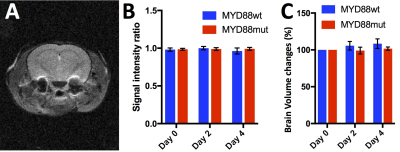 |
38 |
Hyperpolarized [1-13C] pyruvate as a biomarker for treatment monitoring in lymphoma murine models
Video Permission Withheld
Brice Tiret, Adam Autry, IlWoo Park, Min Lu, Rana Anjum, Lisa Drew, Sebastien Degorce, Michele Mayo, Keith Dillman, John Kurhanewicz, James Rubenstein, Myriam Chaumeil
In primary CNS lymphoma (PCNSL), MYD88 mutation is the most common, and induces a constitutive activation of IRAK4 and NF-kB signaling. AZ1495, a IRAK4 inhibitor, significantly improved OS in MYD88mut PCNSL models, highlighting the clinical potential of IRAK inhibition. However, monitoring of such targeted therapies remains challenging using conventional imaging. Because NF-kB controls metabolism, we questioned if hyperpolarized 13C MRSI could monitor IRAK inhibition in PCNSL. We show that HP-13C MRSI was able to detect a decreased HP lactate production following IRAK inhibition in MYD88mut tumors, not wild-types, highlighting the potential of metabolic imaging for monitoring therapy response in lymphomas.
|
|
3711.
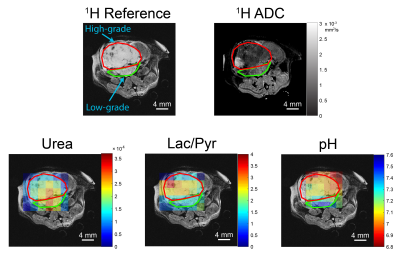 |
39 |
 Hyperpolarized In vivo pH Imaging Reveals Grade-Dependent Interstitial Acidification Hyperpolarized In vivo pH Imaging Reveals Grade-Dependent Interstitial Acidification
David Korenchan, Robert Bok, Renuka Sriram, Romelyn Delos Santos, Hecong Qin, Daniel Vigneron, David Wilson, John Kurhanewicz, Robert Flavell
Changes in cellular metabolism, perfusion, and proton export that occur during indolent-to-aggressive transition in prostate cancer (PCa) likely lead to a lower extracellular pH (pHe) in vivo, promoting an aggressive, treatment-resistant phenotype. To measure this interstitial acidification, we implemented a hyperpolarized (HP) imaging protocol that measured lactate-to-pyruvate ratio, perfusion, and pHe in a murine model of prostate cancer, the TRAMP mouse. Our results indicated higher pyruvate-to-lactate conversion, lower perfusion, and lower pHe in high-grade tumors, suggesting a correlation between the three parameters and implicating low pHe in the development of aggressive PCa.
|
|
3712.
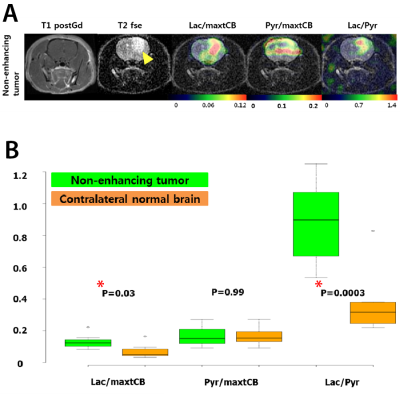 |
40 |
 Characterization of Distinctive in vivo Metabolism between Enhancing and Non-enhancing Brain Tumors Using Hyperpolarized Carbon-13 MRI Characterization of Distinctive in vivo Metabolism between Enhancing and Non-enhancing Brain Tumors Using Hyperpolarized Carbon-13 MRI
Seongwoong Kang, Ilwoo Park
This study applied 13C MR metabolic imaging with hyperpolarized [1-13C]pyruvate for the differential characterization of metabolic profiles between enhancing and non-enhancing brain tumors. The levels of lactate, which was normalized by vascular total carbon signal, were significantly different between the contralateral brain, non-enhancing and enhancing tumor, while the levels of pyruvate were similar between these three tissues. The results from this study suggested that this technique may be useful in distinguishing functional characteristics between normal brain tissue and heterogeneous anatomical lesions in brain tumors.
|
|
3713.
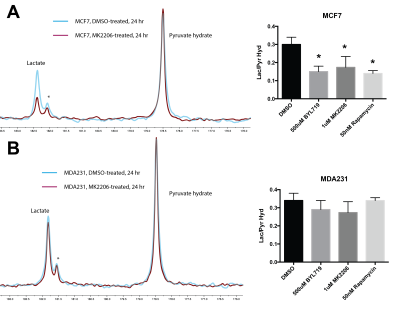 |
41 |
Detection of Targeted Therapy Treatment Response using Hyperpolarized Magnetic Resonance Spectroscopy in Breast Cancer Cell Lines
Did Not Present
Sui Seng Tee, Kristin Granlund, Roozbeh Eskandari, Sangmoo Jeong, Steven Truong, Kayvan Keshari
Hyperpolarized magnetic resonance spectroscopy (HP-MRS) allows non-invasive real-time monitoring of cancer metabolism. This unique ability allows investigation of changes in cancer metabolism after therapy. This study demonstrates the utility of this modality to detect lowered conversion of hyperpolarized pyruvate to lactate after targeted therapy against a commonly mutated growth signaling pathway in cancer. We also demonstrate changes in enzyme phosphorylation that may explain changes in HP-MRS.
|
|
3714.
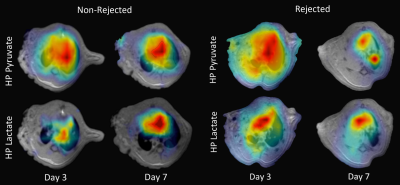 |
42 |
 HP [1-13C] Pyruvate-derived metabolic biomarkers are an early predictor of lung rejection in the rat lung transplantation model HP [1-13C] Pyruvate-derived metabolic biomarkers are an early predictor of lung rejection in the rat lung transplantation model
Sarmad Siddiqui, Mehrdad Pourfathi, Andreas Habertheuer, Yi Xin, Hooman Hamedani, Prashanth Vallabhajosyula, Ali Naji, Rahim Rizi
Post-transplant lungs are clinically monitored using regular radiography and/or CT scans to detect rejection. We proposed that a metabolic biomarker may provide higher sensitivity than conventional tools at the onset of rejection, before permanent structural changes in the lungs. Using HP [1-13C] pyruvate CSI, we found that the HP lactate-to-pyruvate ratio in the transplanted lung was significantly elevated in the rejected cohort (~1.7-fold on day 3, ~2.7-fold on day 7) compared to the non-rejected cohort and can be potentionally used as an early predictor of lung rejection.
|
|
3715.
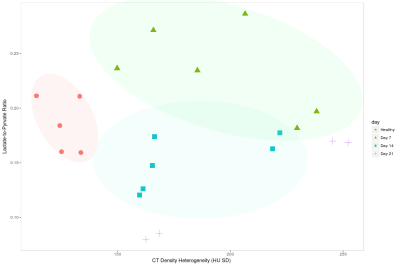 |
43 |
 A Multimodal Imaging Approach to Characterize the Onset of Pulmonary Fibrosis A Multimodal Imaging Approach to Characterize the Onset of Pulmonary Fibrosis
Sarmad Siddiqui, Mehrdad Pourfathi, Stephen Kadlecek, Yi Xin, Harrilla Profka, Rahim Rizi
Pulmonary fibrosis is typically an progressive, irreversible disease. However, in many cases, the onset of fibrosis is preceded by persistent inflammation; unfortunately, the two presentations are challenging to assess radiologically, and misdiagnoses can limit treatment options. In this in vivo rat study, the metabolic state the lung—derived via HP [1-13C]-pyruvate MRSI—and the structural heterogeneity of the lung—imaged via CT—were used in tandem to distinguish healthy lungs, inflamed lungs, and lungs with early onset fibrosis, creating an extremely sensitive tool for differentiating between the different phases of pulmonary fibrosis.
|
|
3716.
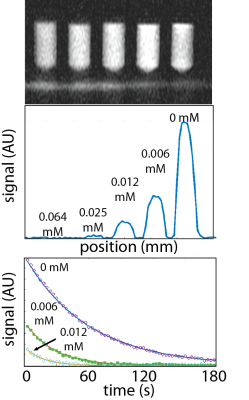 |
44 |
 Investigating Ferumoxytol as a Relaxation Agent for Hyperpolarized 13C Magnetic Resonance Investigating Ferumoxytol as a Relaxation Agent for Hyperpolarized 13C Magnetic Resonance
Michael Ohliger, Cornelius von Morze, Jeremy Gordon, Eugene Milshteyn, Chengcheng Zhu, David Saloner, John Kurhanewicz, Daniel Vigneron
Hyperpolarized carbon-13 MRI is a powerful emerging molecular imaging technique but it lacks tissue specificity. Selective relaxation of hyperpolarized signals by targeted gadolinium chelates has been explored to increase specificity. However, gadolinium agents have very low 13C relaxivities. We explore the use of the super paramagnetic iron oxide, ferumoxytol, by measuring the transverse and longitudinal relaxivity for two commonly imaged hyperpolarized 13C metabolites, namely [1-13C]pyruvate and [1-13C]lactate in comparison to gadopentetate. Longitudinal relaxivity of ferumoxytol is nearly 30 times higher for 13C compounds than gadopentetate. This enhanced relaxivity is expected to lead to especially low dose requirements in eventual biological translation.
|
|
3717.
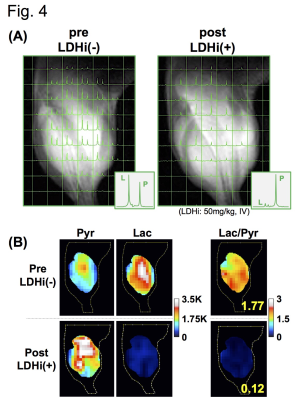 |
45 |
 Developing a therapeutic strategy for a glycolytic cancer model by monitoring on-target in vivo efficacy of a newly developed LDH inhibitor using hyperpolarized 13C Magnetic Resonance Imaging Developing a therapeutic strategy for a glycolytic cancer model by monitoring on-target in vivo efficacy of a newly developed LDH inhibitor using hyperpolarized 13C Magnetic Resonance Imaging
Nobu Oshima, Shun Kishimoto, Krisitin Beebe, Dan Crooks, Kazutoshi Yamamoto, Jeffery Brender, Ganesha Rai, Daniel Urban, Goria Benavides, Giuseppe Squadrito, Victor Darley-Usmar, Matt Hall, James Mitchell, Murali Krishna, Leonard Neckers
This study aimed to develop a new therapeutic strategy with a novel Lactate Dehydrogenase A inhibitor (LDHi) for cancers bearing the Warburg phenotype by monitoring the impact on in vivo metabolic flux of the LDHi using hyperpolarized 13C-MRI. 13C-MRI with hyperpolarized [1-13C]pyruvate revealed in vivo pharmacodynamics and an effective dose of the LDHi without the need for tissuse sampling. In addition, based on these results, we developed a therapeutic strategy with the LDHi for mice harboring a MiaPaCa-2 (a glycolytic pancreatic cancer cell line) xenograft. This methodology can be a novel approach to treat glycolytic cancers.
|
|
3718.
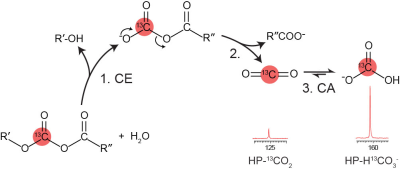 |
46 |
 Esterase-catalyzed production of hyperpolarized 13C carbon dioxide in tissues for measuring pH Esterase-catalyzed production of hyperpolarized 13C carbon dioxide in tissues for measuring pH
Nesmine Maptue, Weina Jiang, Alexander Funk, Wei Chen, Craig Malloy, A. Dean Sherry, Chalermchai Khemtong
13C-MRI HP 13C-bicarbonate (H13CO3-) and carbon dioxide (13CO2) is a novel technique for tissue pH mapping. Here, we report 13C-enriched ethyl acetyl carbonate (13C-EAC) for esterase-catalyzed production of HP-13CO2 and HP-H13CO3- for pH measurements. Our results showed that 13C-EAC was rapidly hydrolyzed by esterase to 13C-monoacetyl carbonate, which decomposed to HP-13CO2. Equilibrium between the newly produced 13CO2 and H13CO3- was established and the 13C-NMR signals can be quantified for pH measurements. Finally, in vivo pH measurements using H-13C-EAC was demonstrated in rat livers. These results suggest that HP-13C-EAC is a novel imaging probe for in vivo pH measurements of tissues.
|
|
3719.
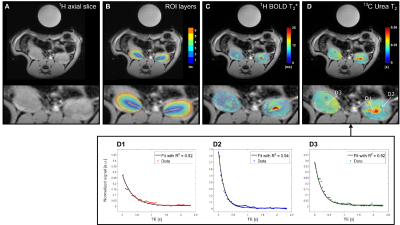 |
47 |
 Hyperpolarized [13C,15N2]urea T2 relaxation changes in acute kidney injury Hyperpolarized [13C,15N2]urea T2 relaxation changes in acute kidney injury
Christian Mariager, Per Nielsen, Haiyun Qi, Steffen Ringgaard, Christoffer Laustsen
BOLD T2* MRI is a surrogate marker of tissue pO2 alterations associated with renal disease, but is limited by perfusion. Hyperpolarized [13C,15N2]urea is an alternative marker of renal function that correlates with normal renal oxygenation. We investigated the correlation between BOLD T2* and 13C-urea T2 in an acute kidney injury (AKI) model. We found that hyperpolarized urea T2 correlates with renal BOLD T2* in the healthy but not in the AKI kidney, and that whole kidney T2 is modulated significantly by the blood volume in addition to oxygen availability. 13C-urea T2 mapping therefore has potential to assist the BOLD estimation.
|
|
3720.
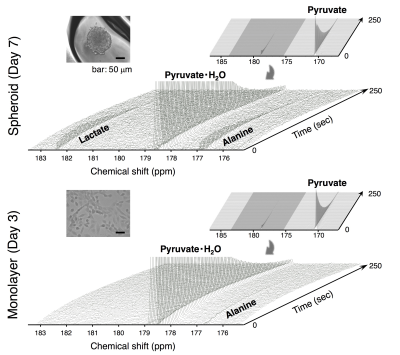 |
48 |
 Hyperpolarized [1-13C]pyruvate MRS reveals early-phase transition of energy metabolism in multicellular spheroid tumors Hyperpolarized [1-13C]pyruvate MRS reveals early-phase transition of energy metabolism in multicellular spheroid tumors
Yoichi Takakusagi, Kaori Takakusagi, Kaori Inoue, Kazuhiro Ichikawa
Hyperpolarized [1-13C]pyruvate MRS was conducted to directly monitor the transition of energy metabolism in tiny multicellular tumor spheroids as a model of early tumorigenesis. As compared with normal tumor cells, the lactate formation from pyruvate was significantly amplified in the tumor spheroids, even in a few hundred micrometer i.d. of smaller ones with no blood vessel formation. These results imply that formation of the sterical structure itself causes the transition of energy metabolism from mitochondria to cytoplasm in tumor tissues. HP [1-13C]pyruvate MRS may thus allow detection of early tumorigenesis by targeting the increased aerobic glycolysis in the initial stage, if much higher performance of HP measurement is realized.
|
|
| Back |
| The International Society for Magnetic Resonance in Medicine is accredited by the Accreditation Council for Continuing Medical Education to provide continuing medical education for physicians. |

































































































